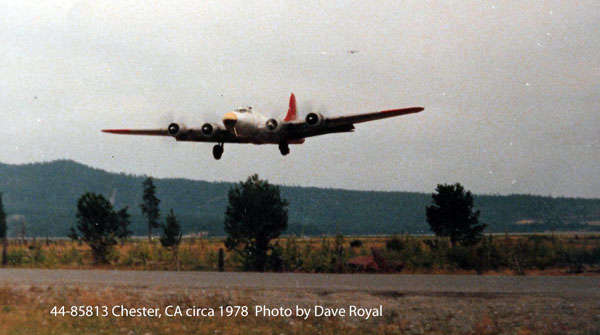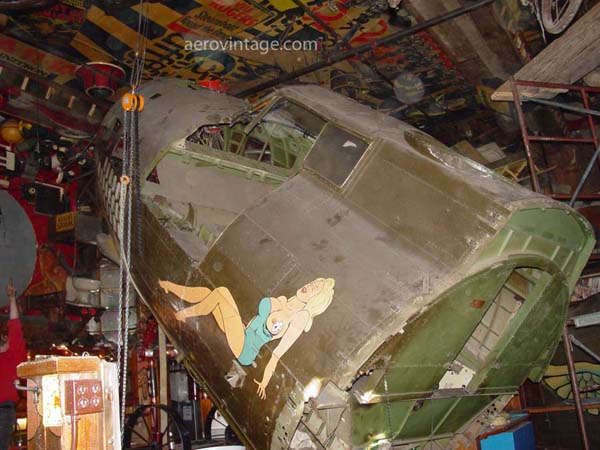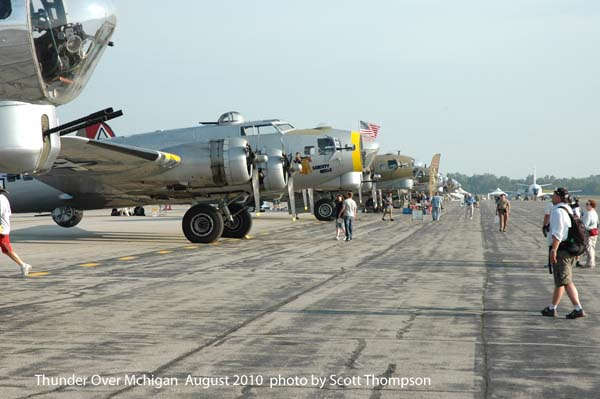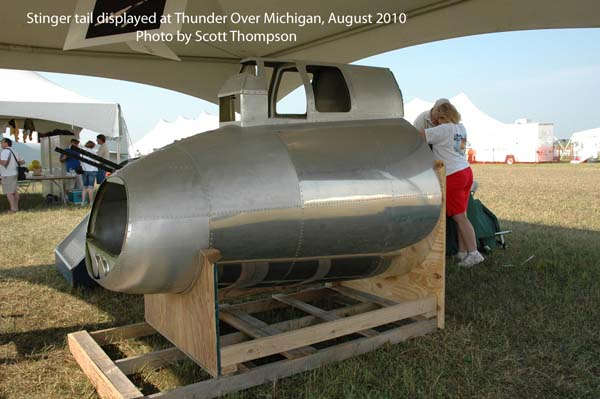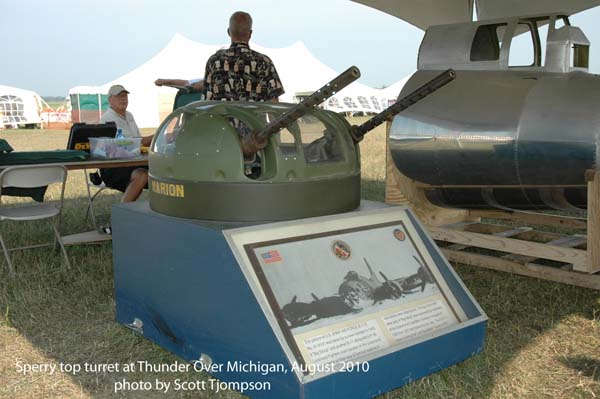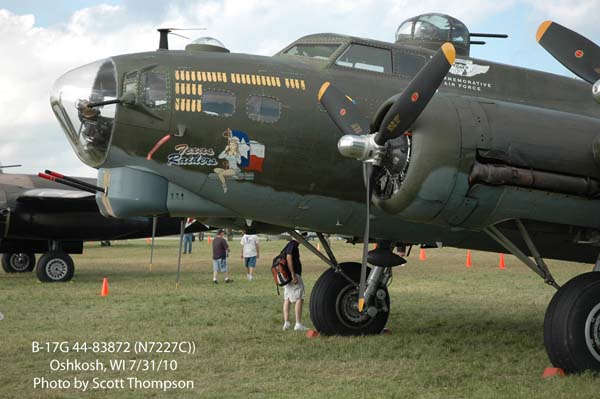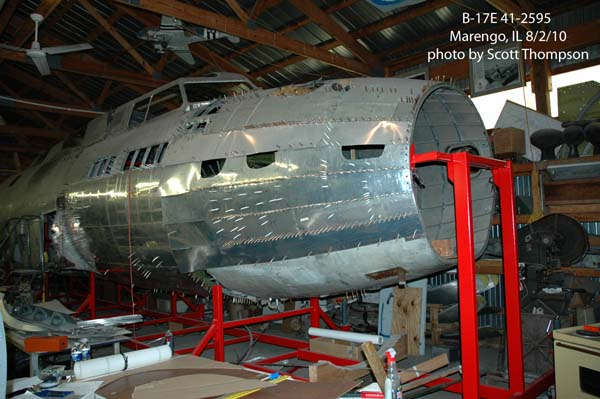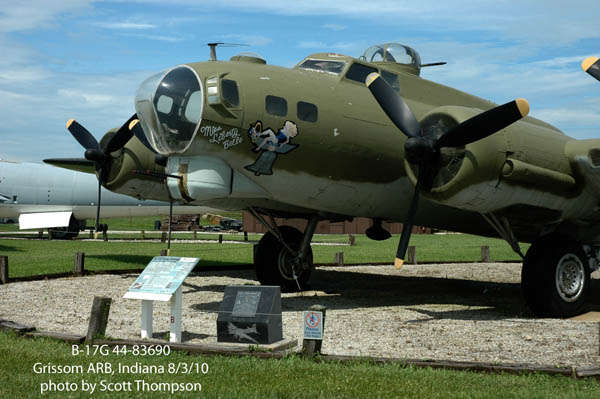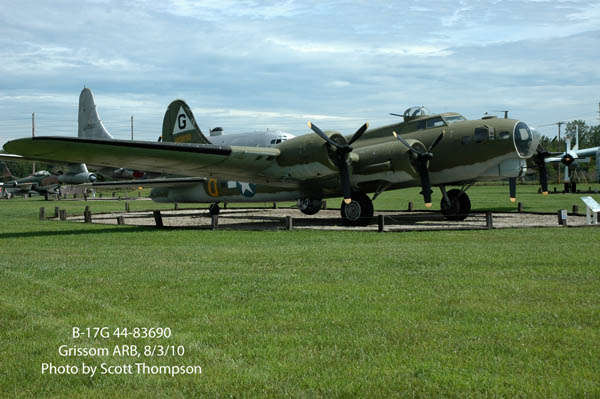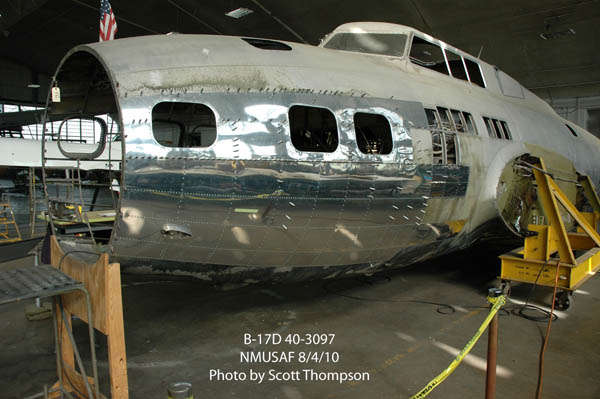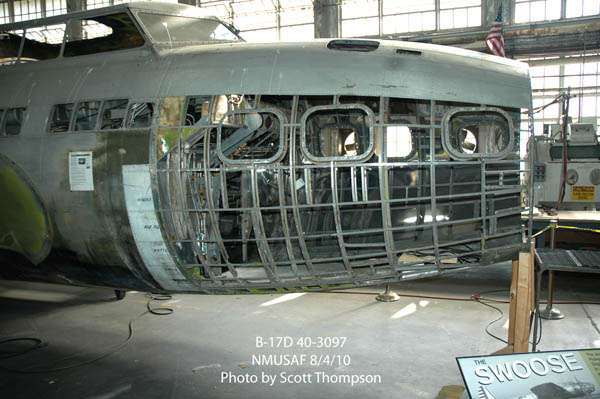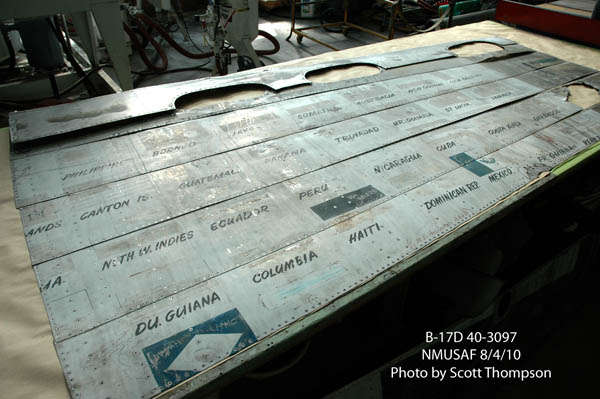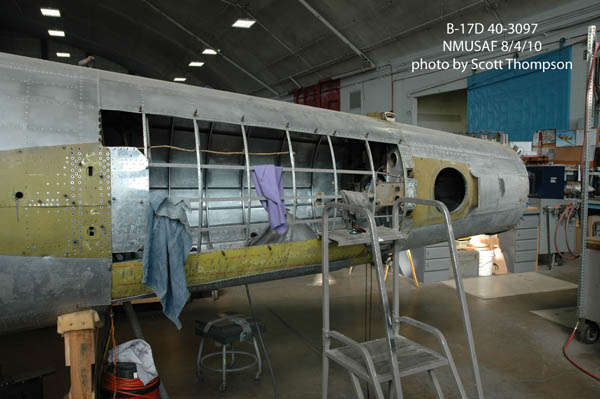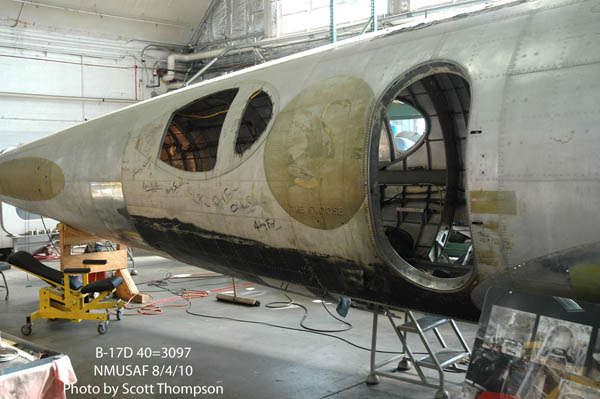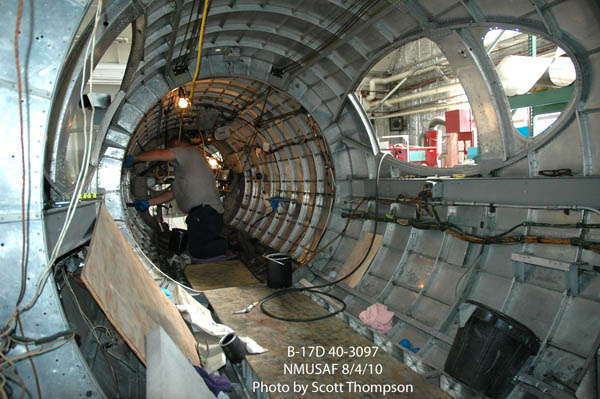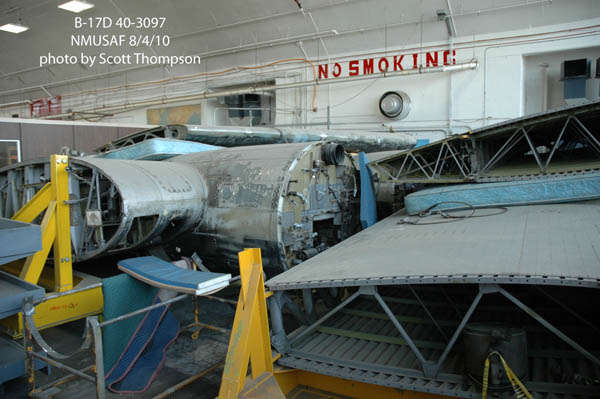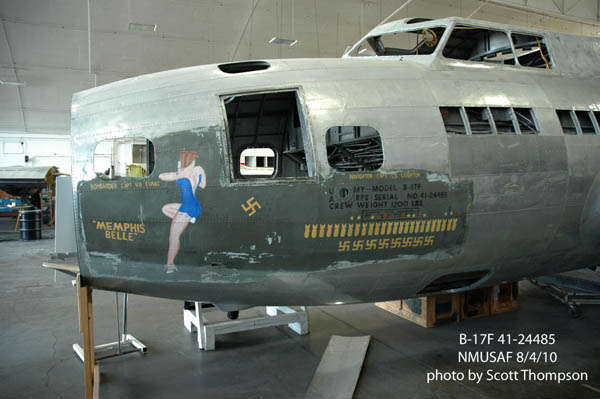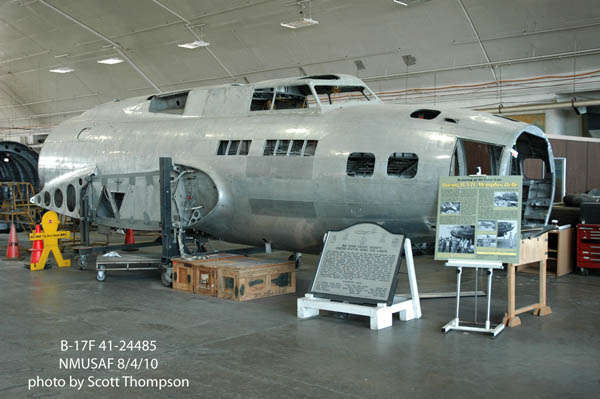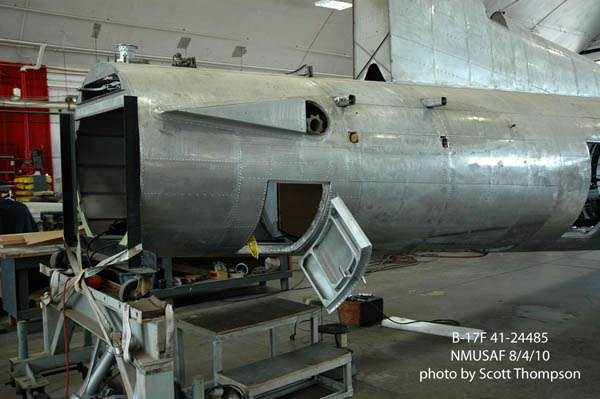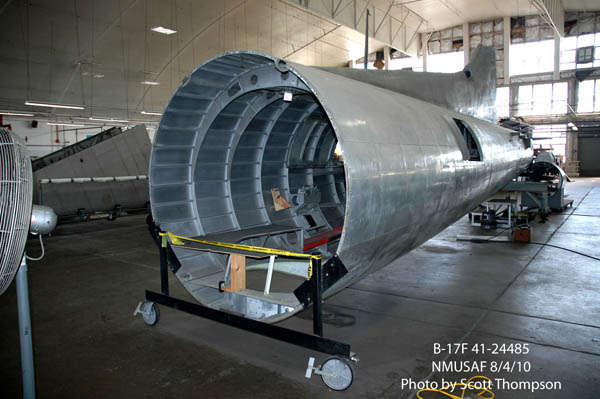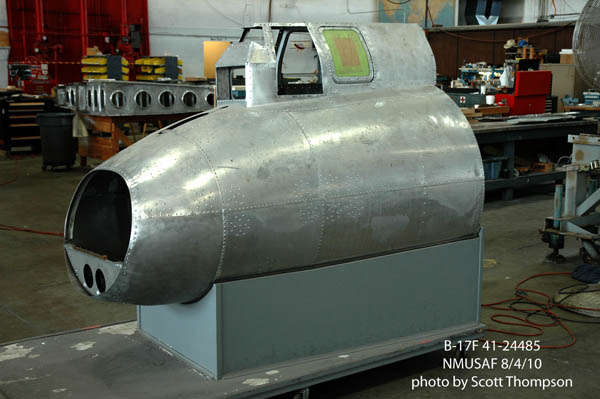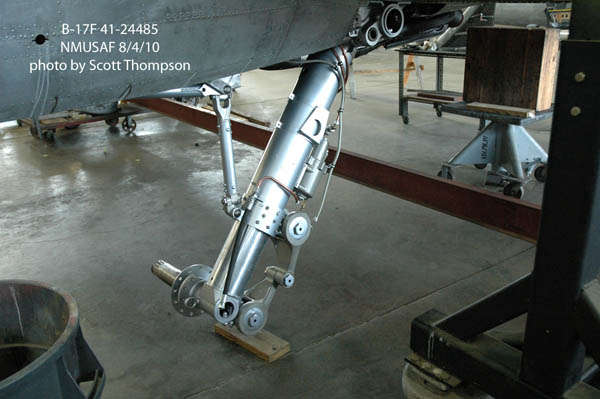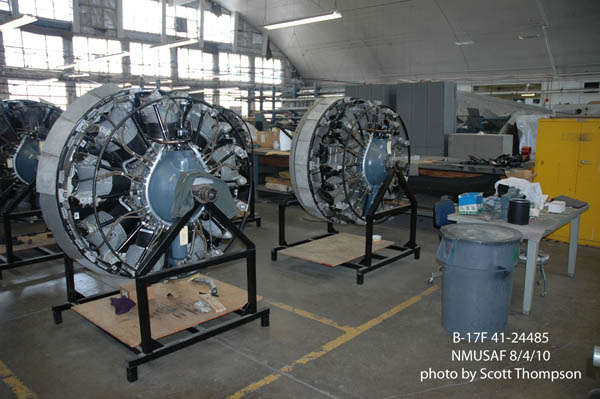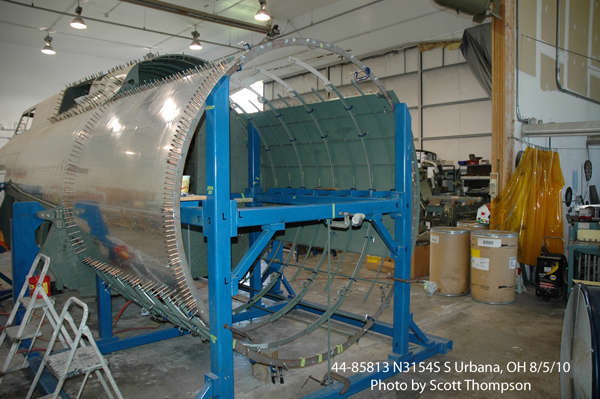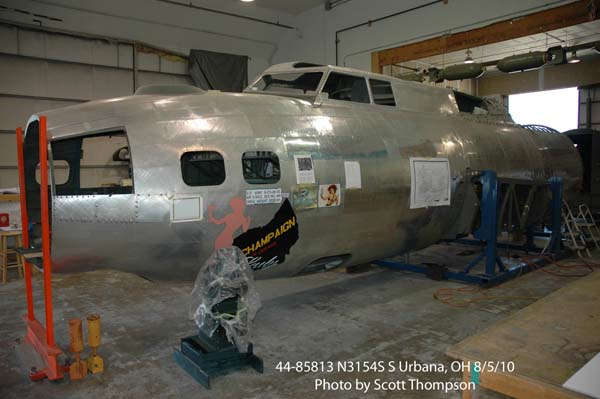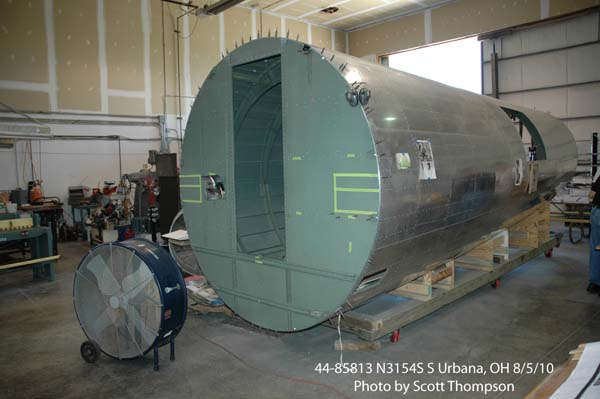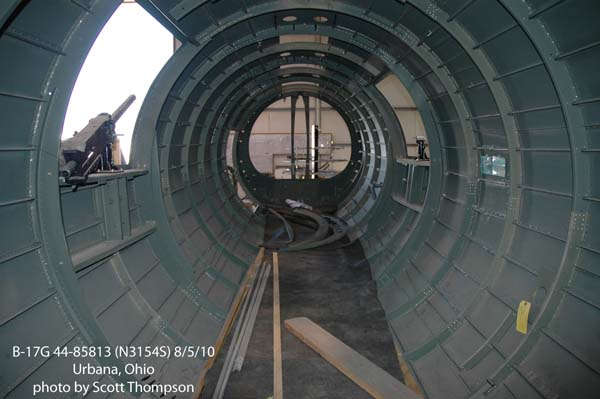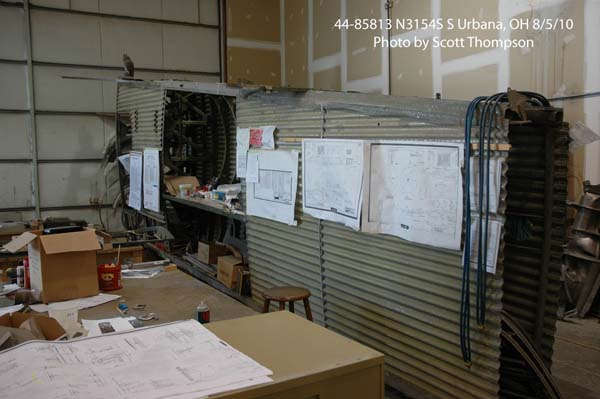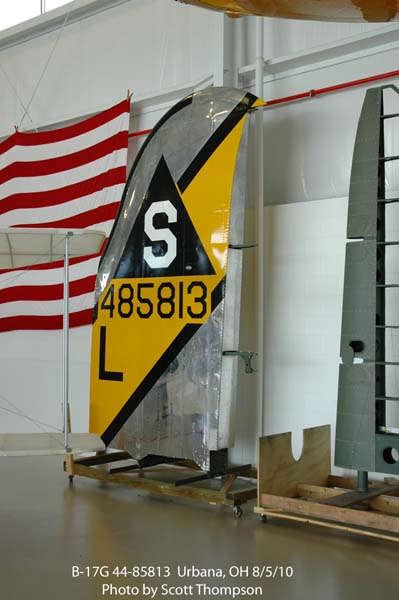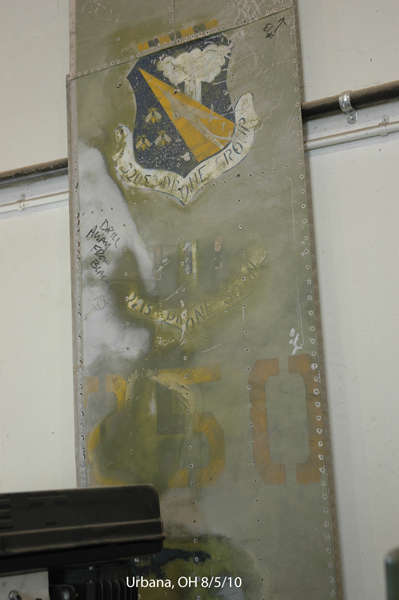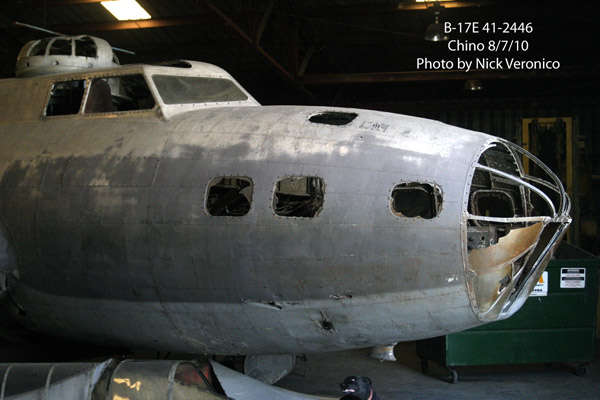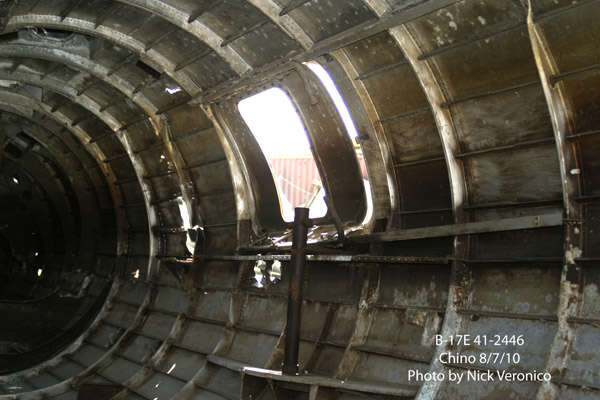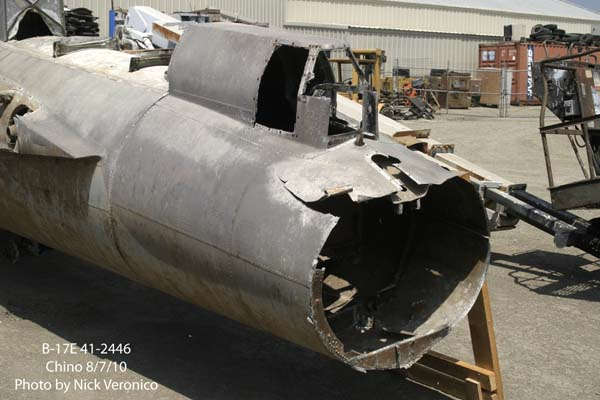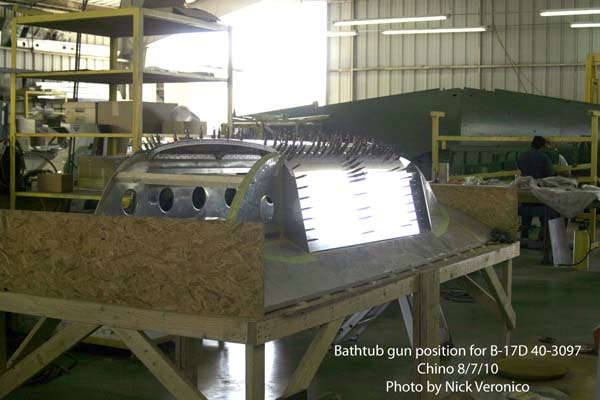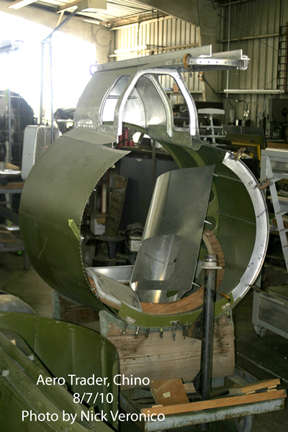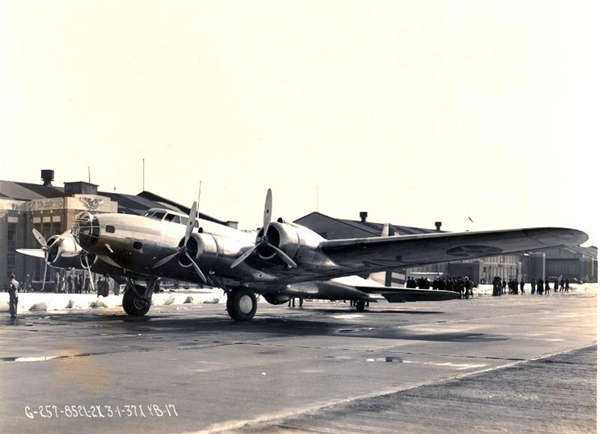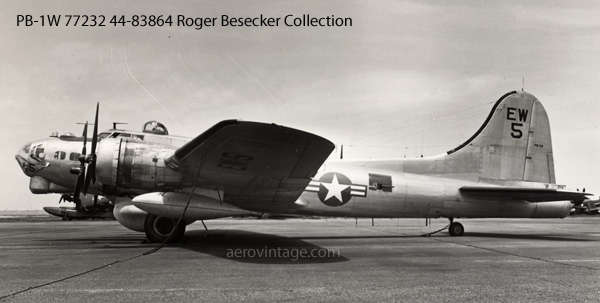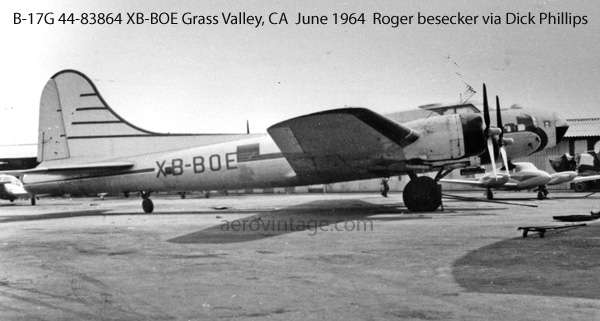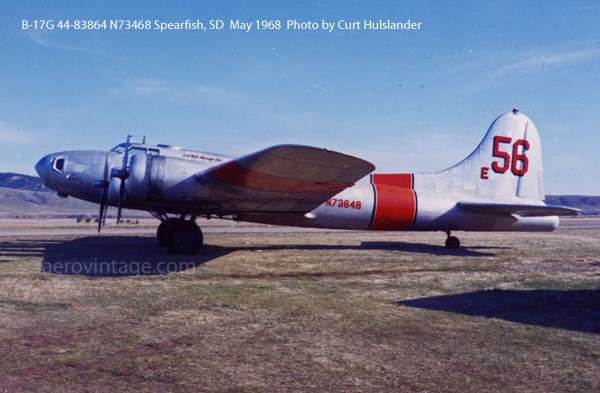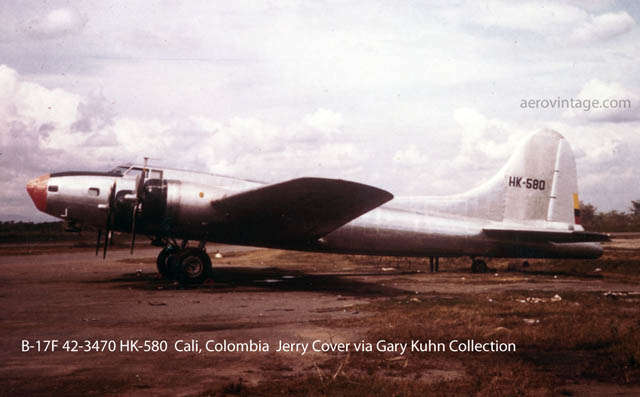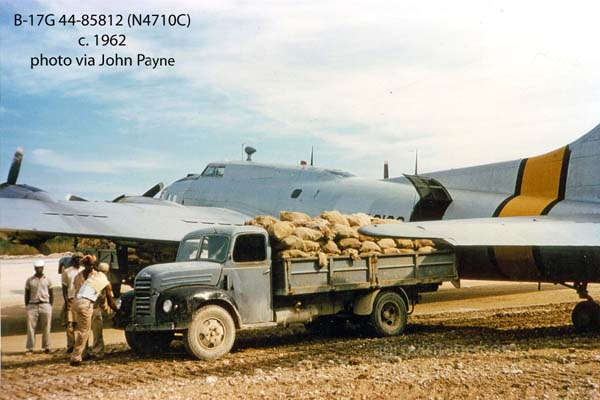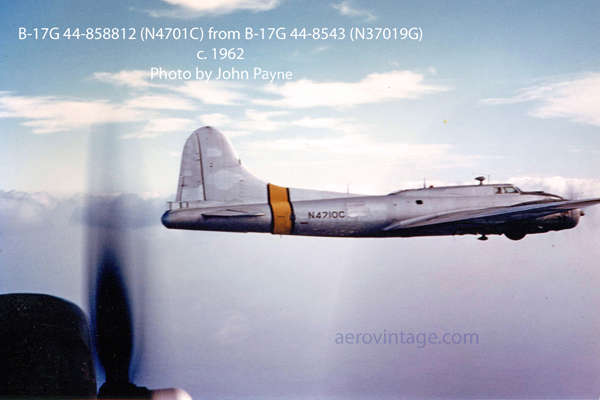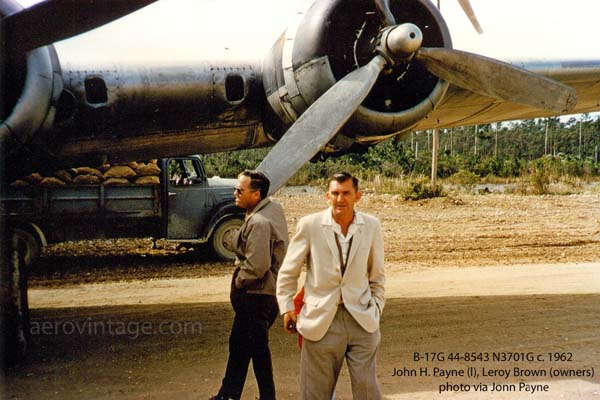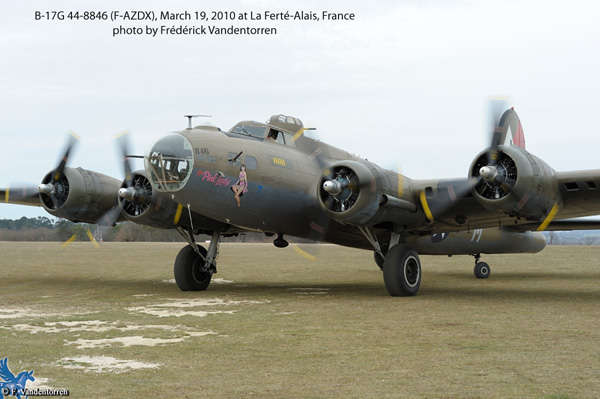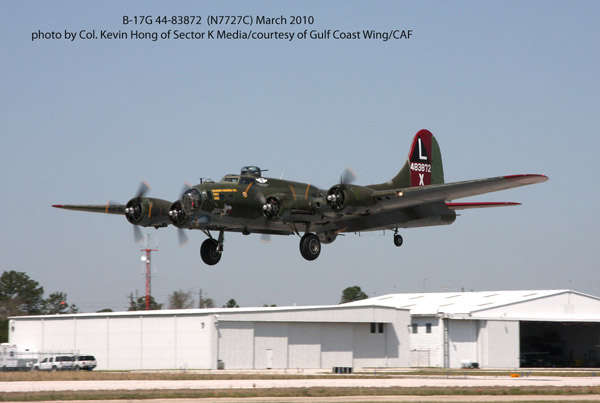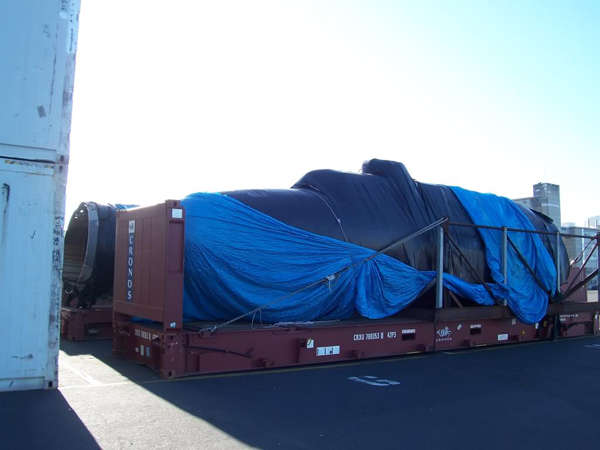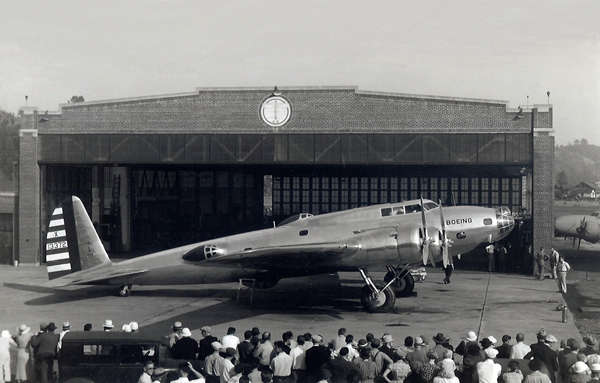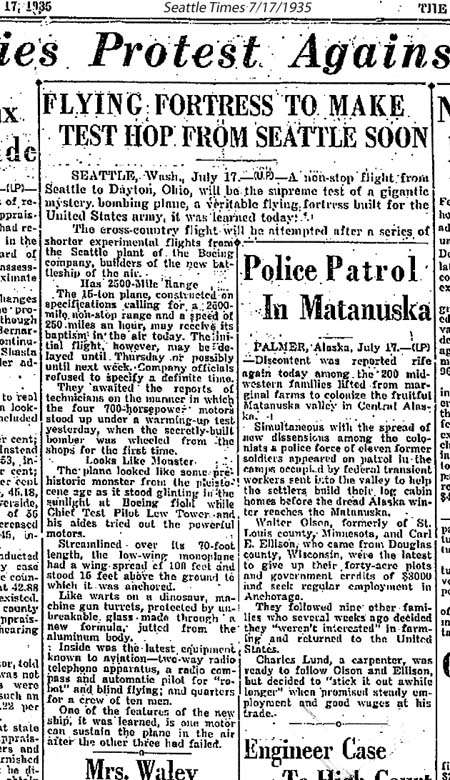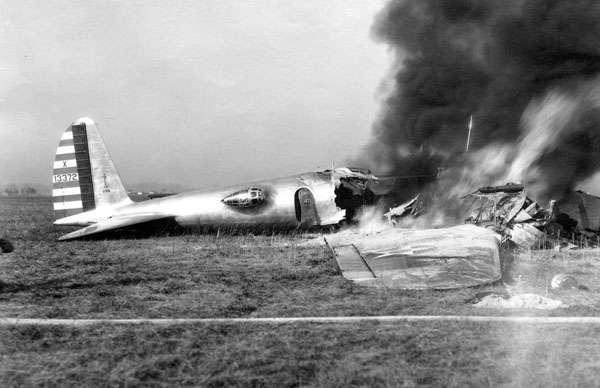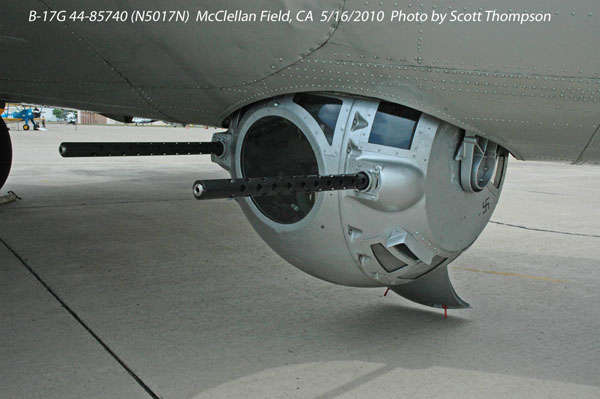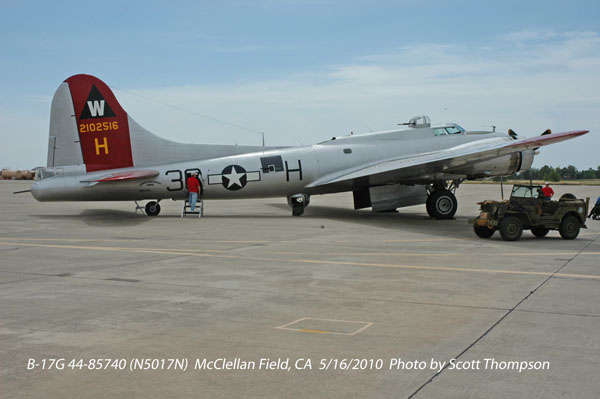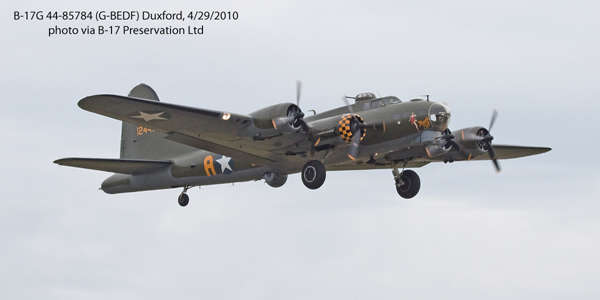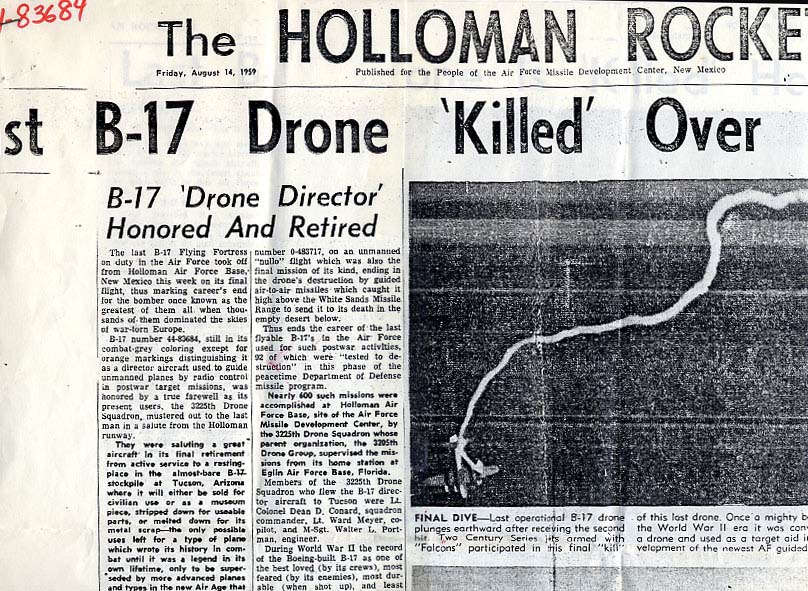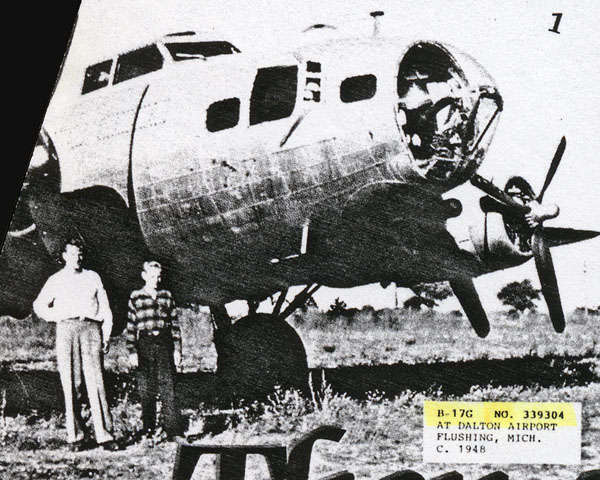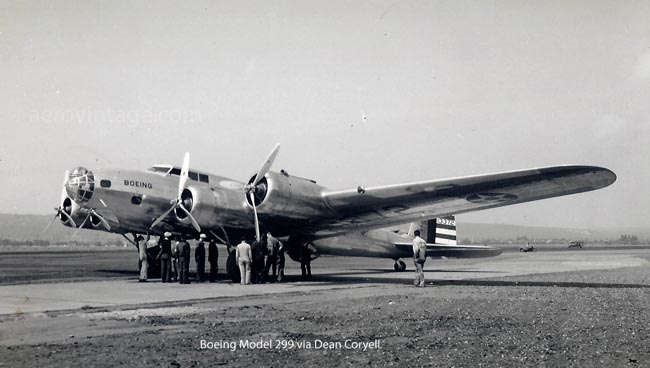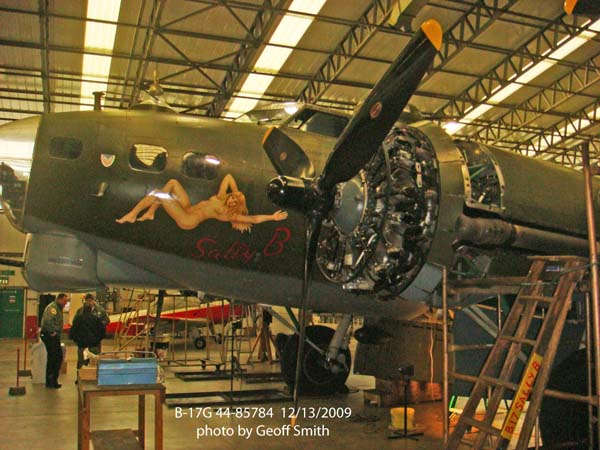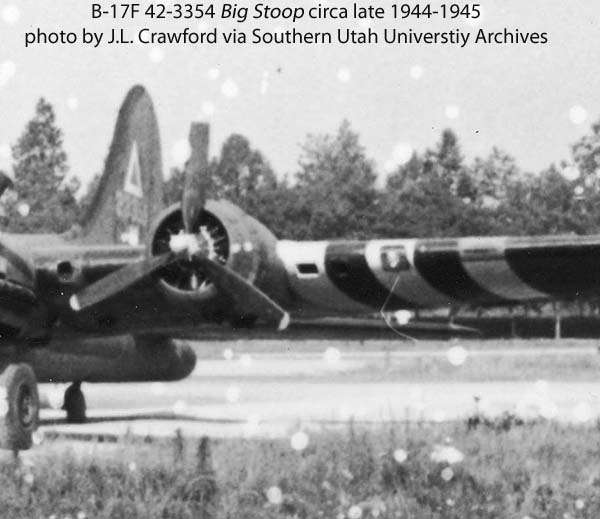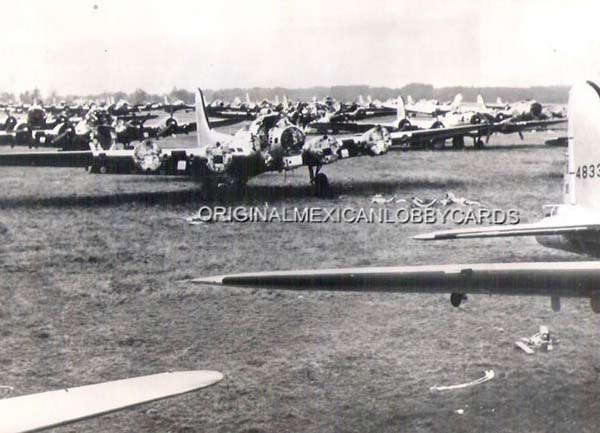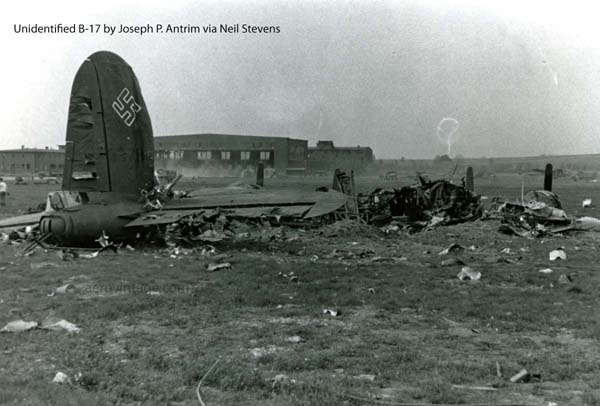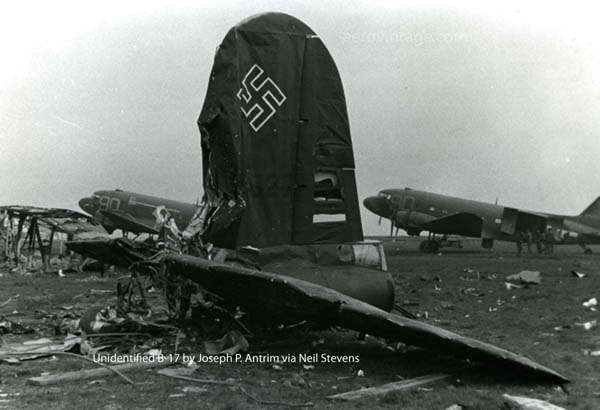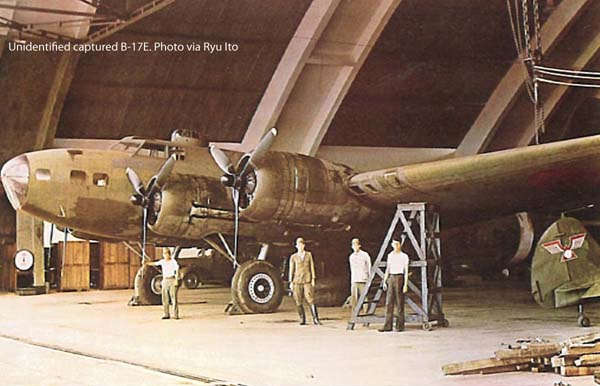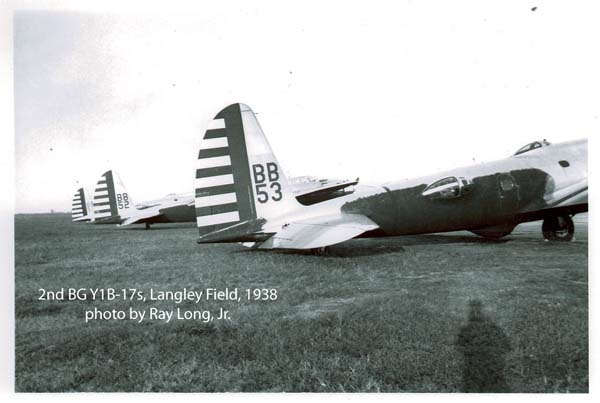
| site search by freefind | advanced |
AERO VINTAGE BOOKS
2010 B-17 NEWS
B-17 News Archive
2018 B-17 News
2017 B-17 News
2016 B-17 News
2015 B-17 News
2014 B-17 News
2013 B-17 News
2012 B-17 News
2011 B-17 News
2010 B-17 News
2009 B-17 News
2008 B-17 News
2007 B-17 News
2006 B-17 News
2005 B-17 News
2004 B-17 News
2003 B-17 News
2002 B-17 News
1997-2001 B-17 News
Back to the Main Page
We're including this page as an update point for B-17 news. We'll post information garnered from any variety of sources, and notate that source at the end of the item. If anyone has anything they'd like to add, please let us know.
B-17 Tour Information
- The Collings Foundation B-17G Nine-O-Nine, 44-83575 (N93012), is back in the stable for 2010. Tour dates with the B-17, B-24, and P-51C, dates for 2011 will be posted in December. For the most current information, jump to here for schedule information.
- The Commemorative (ex-Confederate) Air Force's B-17G Texas Raiders, 44-83872 (N7227C), is flying again as reported here and other places. Jump to here for the most current information but expect appearances in 2010 and maybe back into the ride program. See also this informative WIX topic.
- The CAF's other B-17G, Sentimental Journey, 44-83514 (N9323Z), has no dates posted but the aircraft are available. The Arizona Wing's page can be found here for the only Wing information posted for Sentimental Journey.
- The Experimental Aircraft Association's B-17G Aluminum Overcast, 44-85740 (N5017N), tour for 2010 is over. Check out the most current information here.
- The Liberty Foundation tours with this most recent B-17 restoration, Liberty Belle, B-17G 44-85734 (N390TH). The 2010 tour is over. Check out the current schedule here.
- The Yankee Air Force out of Willow Run, Michigan, operates the magnificent B-17G, 44-85829 (N3193G), Yankee Lady. The museum is still reeling from the devastating fire that destroyed the hangar facilities but fortunately spared both the B-17 and B-25. No dates are currently scheduled. Jump to here for their most current information.
- The Lone Star Flight Museum's Thunderbird, 44-85718 (N900RW), based at Galveston, Texas, offers a ride program. The museum was devastated by Hurricane Ike in 2008, disrupting operations to say the least. The B-17 has no dates scheduled for the balance of 2010 but check out the most current schedule at right here.
December 2010
- Chuckie's New Home: Fighter Factory: Yep, it's hard to believe, but the venerable and well-known B-17G, 44-8543 (N3701G), best known as Chuckie, has been sold by the Vintage Flying Museum and Chuckie Hospers to Jerry Yagen's Fighter Factory based at the Virginia Beach Airport at Virginia Beach, Virginia. (That would be in Virginia, folks.) The FAA registered owner was changed to Training Services of Virginia Beach on October 29, 2010, making it officially official. Training Services is an company associated with Jerry Yagen, Fighter Factory, and the Military Aviation Museum.
This B-17G was one of the early B-17 warbirds, having been purchased by the late Dr. William Hospers in 1978, from the remnants of the fire ant operation based at Dothan, Alabama. It was a labor of love for Hospers and his family and a small group of dedicated volunteers, an effort that morphed into forming the Vintage Flying Museum based at Meacham Field, Fort Worth, Texas. Not surprisingly given the cost and huge maintenance overhead of operating a B-17, the effort was often beset by funding and mechanical issues but, for the better part of three decades, Chuckie was either flying or "in work" to fly at the hand of these guys. Kudos to them, particularly to Bill and Chuckie Hospers as the drivers of the effort, but also to the dozens of volunteers and donors who made it work. It has to be a bittersweet time for Chuckie and those guys at Ft. Worth. The airplane has been close to flying again for several years, with one setback after another. It isn't cheap or easy, and resources are limited. Scraping up a $50,000 insurance premium every year has to be daunting but necessary. Nonetheless, when the airplane leaves for Virginia it will leave a void in the VFM hangar that just cannot ever be filled.
So, in a somewhat surprising sale, the airplane will be moving to a new home probably in early 2011. It still is not flying, but should be within the next month or so. It will presumably be based at the Military Aviation Museum facility at Virginia Beach on a, refreshingly, grass runway. Also operated from the field is another Yagen heavy hitter, the B-25 Wild Cargo. It would be expected that Chuckie will get a Fighter Factory facelift at some point and that the airplane will be regularly flown.
Editorial comment: For all those who are dedicated to keeping these B-17s flying, a hearty and deserved thank you from all of us in the crowd. Whatever your motivations, it takes a tremendous investment of time, money, and people to keep these old airplanes flying, something that is often overlooked in petty criticisms of availability, paint schemes, historical accuracy issues, and attitudes.
- N3701G #1 vs. N3701G #2: Reviewing the FAA Registry's website to get the above information on the new owner of B-17G 44-8543 (N3701G) brought to mind a little mystery that has confounded serious B-17 researchers for decades. For, you see, if you pull N3701G from the FAA site, you also find that there was another B-17G that carried the number first, that being ex-USAF drone controller DB-17P 44-85600. This airframe was one of four purchased by American Compressed Steel Corp. in August 1959, the other three being 44-83563, 44-83439, and 44-8543. It should be noted that Australian Greg Board was a principal in both American Compressed Steel and its subsidiary Aero American, as his signature shows up on many of the owner and registration documents.
Now, try and follow this along: 44-85600 was initially reserved the civil registration of N3696G but as early as November 1959, was shown in the registration paperwork as N3701G. On November 15, 1959, it was sold for $12,300 to Grower's Export Import Co. of Miami, Florida. None of the paperwork was filed with the FAA until mid-December, however, and after it was all shook out, the file was lacking a bill of sale from the USAF to American Compressed Steel Corp., so 44-85600 was never officially assigned any civil reigstration. The owner of Grower's Export Import, one W.F. Parker, was informed by the FAA on February 17, 1960, of the paperwork "challenges" and the inability to issue a civil registration. He had already spent more than a few bucks on the airplane for, besides the purchase price, he hired mechanics to seal the bomb bay and install a floor to support a 33,000 pound cargo load. However, with no response from Grower's Export Import, the FAA followed up with a letter in April 1960 requesting the documents. Not to worry, though, as the airplane was reported destroyed in an accident and the registration number was cancelled from the aircraft officially in September 1960. One would suspect by "destroyed" the owner really meant it was delivered out of the country, possibly to South America or a Caribbean country. It virtually disappeared from sight but one suspects it was exported and not scrapped, given the owner's investment, or involved in a U.S. accident, given the lack of such an accident report. There remain a number of "under-identified" Bolivian civil B-17s, plus an odd assortment of other unidentified B-17s that plied the skies in that part of the world in the early 1960s.
For what it's worth, the USAF record card does show 44-85600 as an excess DB-17P at Davis-Monthan as of May 1959, so it would appear that this aircraft probably did get sold as surplus.
Also, for what it's worth, the FAA file for 44-8543, that is, the one currently flying as Chuckie and N3701G was purchased by American Compressed Steel in August 1959 and then transferred to subsidiary company Aero American in November 1960. No paperwork was filed with the FAA until November 1960 when Board, shown as president of Aero American, filed the ownership chain and registration applications with the requested registration of N3701G penciled in. So, it would appear that between three and nine months after the first N3701G disappeared, Greg Board requested that the number be reissued to another of his B-17s. Peculiar, peculiar, peculiar. There is more research needed to try and slice out a bit information about American Compressed Steel, Aero American, and how these two airplanes fit into the story. Of course, then, there are many who wonder why some people spend so much time pondering such obscure things. What can I say? It's a curse.
Okay, then, what of the other two B-17s purchased in August 1959, you ask, by American Compressed Steel? Well, 44-83563 flies as Fuddy Duddy and 44-83439 became N131P and was converted into a flying aquarium to import tropical fish into the U.S. Now, that's another story, eh?
Finally, I would be remiss if I did not also mention that Pete Bowers identified a third B-17G registered as N3701G in his 1985 50th Anniversary Boeing B-17 Flying Fortress done for the Museum of Flight. In the appendix, he shows 44-8573 as being the first N3701G but I have found nothing to support this and suspect, alas, that it was error in transcription from 44-8543.
Whew. Got through that one.
- Swoose Gets the Tub Mounted: Hot off the press are these NMUSAF photos of the Aero Trader constructed B-17D bathtub gun mount being installed on B-17D 40-3097 by the NMUSAF restoration crew.
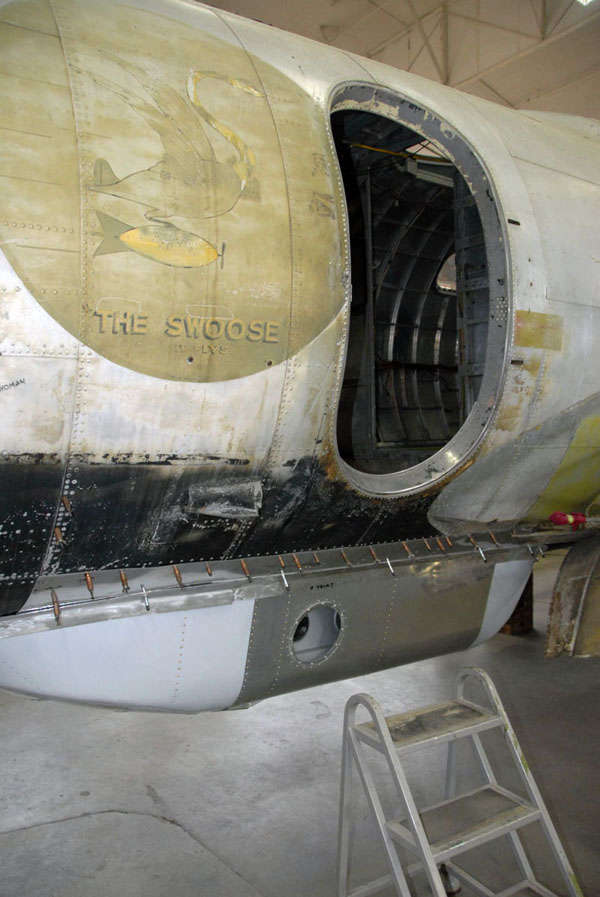
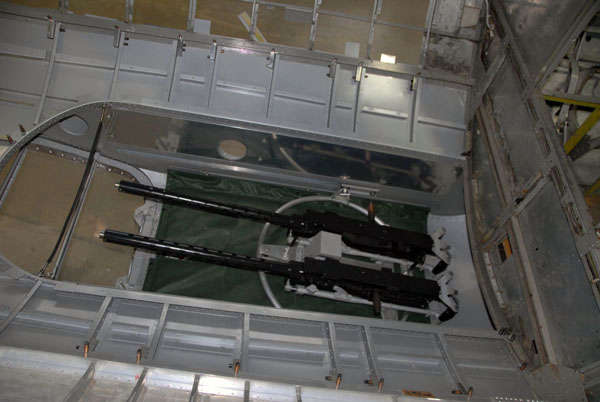
Interesting to me how they are installing it prior to stripping, cleaning, and prepping the aft fuselage skin. Decisions, decisions, decision. But, doesn't it look nice?
- Shameless Plug Media Alert: By the way, for those interested, the December 2010 issue of FlyPast magazine has an engaging little article about the progress of both the Memphis Belle and the Swoose by, ahem, your humble correspondent. But, if you read the update in September, you got the good stuff already. But, nonetheless, buy the mag anyways and let the editor you want dozens and dozens of similar articles by, ahem, well...you get the idea.
- Work Progresses on 'City of Savannah': Patrick Carry feeds me the restoration newsletters put out by the restoration crew of B-17G 44-83814 at the Mighty Eighth Air Museum at Savannah, Georgia. The November 22 update proudly announces that things are going back into the airplane after the interior stripping and painting was completed. A new but accurate radio room floor was added back in recently, as were equipment and radio sets as the effort continues to restore the B-17G back to a combat configuration. You can read the latest at the Mighty Eighth Air Force Museum's webpage dedicated to the effort.
- Old Tankers Never Die (well, yes they do): Dave Royal sent me a nice photo taken back in the good old days at the Chester, California, air tanker base.
Dave provides the following details:
"Here is a B-17 that I snapped a picture of when I was a kid, this must be 77 or 78 I believe. It was working as air tanker C-12 at the time, and through the research of your book it would indicate that this was airframe 44-85813, which I believe part of the remains are being used as Champaign Lady. We used to sit out at the end of a dirt runway at Chester Ca. Air base, which was used as a air tanker base and sit on the fence while these big boy would come and land on the dirt. Made for a great day. Wish I had taken more pictures and had a better camera."
It might be noted that 44-85813 (N6694C) did crash a few years later, but wing sections and some fuselage parts are currently going into the ressurection of this airframe at Urbana, Ohio.
- B-17 Left Wing Section Moving About? Interesting tidbit sent in by correspondent Andy Whiteside who viewed what was apparently the left wing of an unknown B-17 moving on up the highway, in this case Interstate 55, near Cape Girardeau, Missouri. At approximately 10:30 AM on Wednesday, November 17, he observed an 18 wheeler northbound on I-55. He passed along a pretty detailed observation, including this:
"I will tell you what I know for sure about the components that I saw. I was only able to catch a small glimpse, maybe two~three seconds total since I was meeting it at interstate speed. Sadly my phone's camera takes too long to initiate to get an instant photo. A photo of what I saw would be golden. These are the things that I could testify to under oath.....
"There were two single row radial engines, both of which were laying on their backs with the tubular engine mounts attached that resemble the type the 1820s use on the B-17. These were situated on the front of the trailer.
"Behind those were the wing section. Setting high on the trailer was most definitely the left inner wing section with the nacelles. Due to my short exposure I couldn't observe detail like the supercharger intercooler duct openings that define the leading edge between the nacelles of the B-17's wing. But, as I say, I am 99% certain that this was a left wing from a B-17. The nacelles were definitely round, not oval like a B-24 would use. Although, as I say, it would have been nice to observe some additional defining detail to satisfy that other 1% that this wasn't a wing for some other aircraft type.
"What I am uncertain of, however, is what was placed under the inner wing section on the flatbed trailer. I can only speculate here, but I assume the outer wing section was what I saw here. I doubt it was an h-stab, but the brief passing glance that I got would make it impossible to determine which of those two items I saw. It is entirely possible that under the inner wing was engine cowling or something similar. Again, my exposure was all too brief.
"I am also uncertain of the finish. Due to the angle of the sun that morning, I can't say for sure if this wing was in a faded OD paint, or a dulled natural metal. It certainly didn't shine."
Of course, a real dedicated observer would have pulled a Smokey and the Bandit inverted flip reversal over the median and chased down the trucker, but maybe Andy had to stay in the real world that day.
Still, B-17 wing sections, particularly the inner wing sections, are a valuable commodity. I know of several outer wing panels that are out there as spares, but I'm not aware of any spare inner sections. I know a couple of guys who desparately want them. So, here's a bit of a mystery. Perhaps a B-17 being moved from museum to museum? Not aware of any such thing. A newly uncovered left wing heading north? To where? Maybe Swamp Ghost wings, but no reports out of Chino showing movement of the parts. Thanks to Andy for this report. We shall wait over the computer, anxiously awaiting the arrival of an as-yet unwritten email explaining it all, afterwhich I will pass it along right here. Until then, another glass of eggnog, garcon.
- Miss Liberty Belle T-Shirts: The guys at the Grissom Air Park are working toward doing some significant restoration work on the ex DB-17P drone controller, 44-83690. Toward that end, they have prepared some nice T-shirts that are being sold to raise some needed funds. Chris Henry passed along this image of artwork that is reproduced on the shirt:
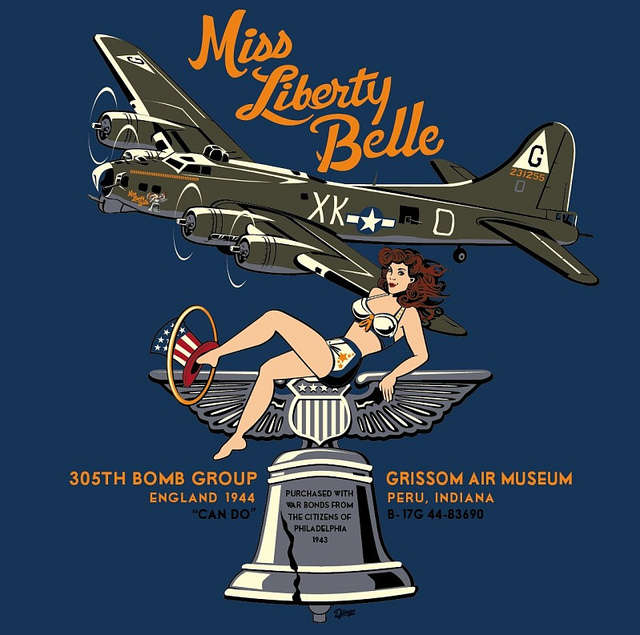
He notes that they are $25 plus $5 shipping and the funds go straight to the restoration of the aircraft. You can contact him at mustangdriver76@hotmail.com. Let him know the size and address, and they can take paypal, or checks. Christmas is coming...your wife would love one and you can support the restoration work.
- Brad Pitt Still a Reader? Apparently so, if this very recent photo is any indication. I can't say for sure where the photo came from...it just magically appeared, but was taken just yesterday. As far as I can tell, it is probably an accurate representation of what Brad is reading these days.

Once again, just like last year, every indication suggests that if you buy a copy of Final Cut you will be just like Brad. Really, what do you have to lose?
For example, look at this unsolicited but undoubtedly accurate testimonial from Buford M. from Pittsburg, PA:

- Finally, Merry Christmas to you and yours. Keep 'em flying!

September 2010
- B-17G 44-83387 to New Orleans? Starting out with a bit of a surprise announcement made on August 27 regarding an ongoing $300 million expansion of the National WWII Museum located in New Orleans. A press release revealed that a restored Flying Fortress will be showcased in the museum. The B-17 is to be displayed in the new United States Freedom Pavilion: Land, Sea & Air.
Since there were no B-17s known to be readily available, it was a bit of mystery as to which airplane it might be. However, Pat Carry was able to get a confirming email from the museum that tells us that it is B-17G 44-83387, currently in storage in Los Angeles, that will be heading east.
Here, from the museum website located here, is an artist's rendering of the museum expansion showing the B-17 (and B-25 also) hanging from the museum ceiling:
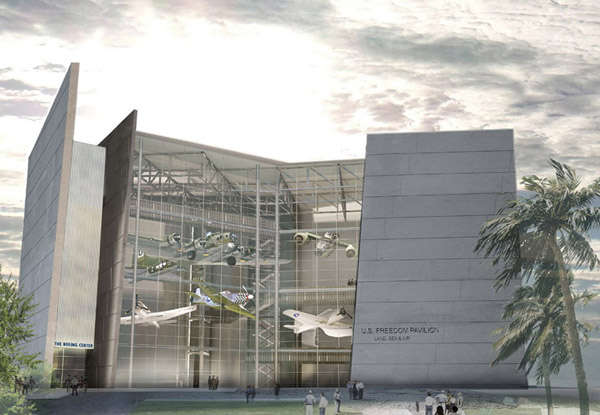
Readers of this site and/or Final Cut will know this to be the fuselage section that came out of the bar in Greeley, Colorado, in February 2007. They also know it originally went from the USAF to Fox studios in 1949 for use as a studio prop in the filming of the movie 12 O'Clock High that same year, and that it was also used in the studio for filming the TV series of the same name, and also appears in Thousand Plane Raid and Tora! Tora! Tora!. It was essentially saved out of the Colorado bar by Bruce Orriss, he of aviation movie prop fame. As it came out of the bar it was mostly just the fuselage forward of the waist gun openings, but Bruce has amassed additional structure and now, it would seem, a complete B-17 will eventually come together for a static display at the New Orleans museum.
Here is my best photo of the airplane, years old, but I am still waiting for someone to snag a photo of the airplane as it exists today. Unless you have one, this one will have to do, from 2007, when the forward fuselage was being lowered in the bar.
Like noted, a bit of a surprise and perhaps bittersweet for some of those involved. We'll have to wait for some more details to emerge to see how all this has played and will play out.
- Thunder Over Michigan: Okay, a great airshow that featured eight B-17s, as announced and planned, came together courtesy of the Yankee Air Force at Willow Run for the weekend of August 7th and 8th. It is actually a bit surprising that all showed up, all thing considered but proof was in the pudding with a long line of B-17s and a lone B-24 greeting airshow visitors.
And, to boot, all eight B-17s got into the air on Saturday for the best part of the aerial part of the show, with seven taking part in the show on Sunday. In no particular order, these are the B-17s that made it: Yankee Lady, Aluminum Overcast, Thunderbird, The Movie Memphis Belle, Texas Raiders, Sentimental Journey, Liberty Belle, and Nine O Nine. Texas Raiders sat out the show on Sunday, having suffered a few landing gear motor issues on Friday and Saturday that precluded it's flight on Sunday. It actually was fixed in time for the airshow on Sunday but plans had surpassed its availability.
I enjoyed three days of B-17 and history immersion, starting with a personal tour of the historic Willow Run Airport conducted by Todd Hackbarth, including a good look at the Ford B-24 factory, several other hangars, and the airfield in general. Spent two days with the Liberty Belle group (thanks, Ron!) signing copies of Final Cut, meeting a lot of very nice folks, and catching up with lots of others. The weather cooperated, and you can expect to see much aviation media coverage of the event in the next few months as it was a great show. There will be some excellent photography to come out of the show, some of which has already started appearing. Much better than anything I shot, but all you camera guys should send in your best stuff and I'll post what I can right here. Kudos to the Yankee Air Force, the hundreds of volunteers, and all the operators, pilots, crewmembers, mechanics, and numerous others who made it possible to pull such an event off.
It should be noted that there were the makings of four other B-17s....projects athat are slowly coming forth, that were in attendence also. These would be the B-17E Desert Rat, the B-17G Champaign Lady, the B-17G (soon*to*become*a*B-17F) that I could call Dyke Lady but probably shouldn't, and the Ray Moore B-17F project that doesn't have a name (9/10/10 Update: Ray Moore advised me that the project airplane name is Lucky Thirteen), even a made up name by me. These guys occupied three tents with various parts and pieces and gleams in their eyes that basically said "get out of my way, we are building B-17s" and so they are.
So, how about a beautiful piece of metal work done, mostly by Tom Wilson, for the Dyke Lake B-17G (soon*to*become*a*B-17F)? Hundreds of parts and dozens of pieces of aluminum alloy skin with an awful lot of compound curves came together in the 'new built' component ready to go into a coming B-17 restoration. Way cool and if Tom Wilson is standing by to tell you how it's done, you get additional color commentary free of charge. There were a bunch of guys wandering around who I've either met or corresponded with over the years but I met, like, 5,000 people in two days so I can't remember them all.
Also displayed is the Sperry power turret that may be going into the Dyke Lake airplane. This turret spent fifty years under the Greenland ice and was one of the components recovered from a B-17E during the P-38 recovery effort that produced the famous Glacier Girl.
This would be just one of several exciting B-17 projects coming along in the background. Again, more details are provided on two of the projects at Thunder further along in this update.
- AirVenture 2010: The other air show in the summer of 2010 was, of course, Oshkosh, which ended the weekend before Thunder. At that show, there were "just" four B-17s. In no particular order, these would be Yankee Lady, Thunderbird, Texas Raiders and , of course, Aluminum Overcast. They were never parked all together, at least not that I saw. Here's a photo of Texas Raiders on the warbird line, just because it was there.
However, they did fly together and, on one occasion, I stood next to a taxiway with the four B-17s running as they held for a delay. Nearby on the grass, the P-38 known as Glacier Girl was sitting also running and waiting with Steve Hinton at the controls. Pretty cool. Not something you see everyday, eh?
- Editorial Comment: Despite the two great shows, I have to admit that I was a bit disappointed what could have been and should have been a celebration of the B-17 as an airplane and what history it made. Frankly, the EAA effort at AirVenture was negligible with the evening of July 28, the actual anniversary date of the first flight of the Model 299, focusing on B-17 pilot Hal Weekly with a tribute to veterans of five U.S. wars, both presentations important and significant in their own right. However, there should have been a B-17 program...about the history of the airplane and what it meant to American aviation and the American air force. Representative B-17s vets should have been included, maybe one from each crew position, and given their due. Maybe the movie for the night could have been Twelve O'Clock High or Air Force?
As for Thunder, boy, it just seemed that with all the B-17s on the field there might have been some effort to bring a cohesive story together, either with a cooperative display or presentation to commemorate the anniversary of the airplane. It seemed a bit disjointed with each airplane an entity unto itself. Not sure how it could have been done better but something seemed to be missing even with eight B-17s on the field.
Perhaps I expected too much...that the B-17 first flew seventy-five years ago and was a pivotal part of developing aviation and air power, made Boeing what it is today, and remains one of the most recognized airplanes ever built, seems to have been overlooked.
- Summer of B-17 Tour:
Well, I spent a ten days with the FAA DC-3, doing the One Last Time event at Rock Falls, Illinois, then proceeded (as part of a 21-strong DC-3 "gaggle" to Oshkosh on Monday, August 2.
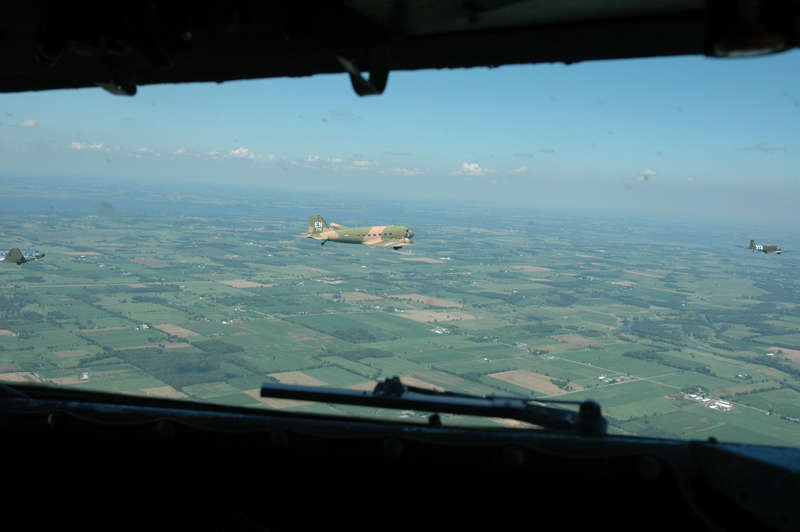
Pretty cool, and something I don't expect to ever have the opportunity to do again. It's significant (to me anyways) that the DC-3 and B-17 are contemporaries, having been designed at the same time, are technologically similar in systems and structural theory (design 'em strong and beefy 'cause who knows?) and both flew first in 1935. And a kissing cousin of the DC-3, that being the B-18, was the competitor that "beat" the Model 299 (XB-17, sort of) in the Air Corps fly-off. But I digress, as this is not "DC-3 News Update."
Anways, after the Oshkosh show, I had a week to spend meandering about the upper midwest. I took advantage of the opportunity and hit a bunch of B-17s and met a bunch of people that I had only emailed or knew about. So, in the particular order taken, here is a bit of a rundown....
- Desert Rat Update: First up was along awaited chance to meet Mike Kellner and Bill Stanczak, two guys who I've emailed and otherwise corresponded with for many years. Never met them before, nor seen the work in progress on B-17E 41-2595. I drove down from Oshkosh to Marengo, Illinois, a small farming town located northwest of Chicago. There, I had the chance to finally see the B-17E and take a close look at the airplane and work underway.
I also had a chance to have dinner with Mike, Bill, and volunteer Ray Ferriss and talk about some of the challenges facing the effort to rebuild an airplane that was literally sawn into several big pieces in the 1940s and left for scrap.
I found out that it's not easy. I also found out they need a bunch more dedicated volunteers, guys who want to stick around for awhile, learn some valuable skills, spend some quality time with a dedicated restoration team and do something worthwhile. I also found out it costs a whole bunch of money, and that any few dollars can help the effort. No tax deduction (yet) for those few bucks, but if that's why you're donating, well.... Anyways, this is huge job and it is privately funded and organized, not an easy task. Hand it to Mike (and wife Cheryl) for sticking with this life-long effort to rebuild this scrap into a B-17. And guys like Bill and Ray and a bunch of others who spend countless hours doing intricate work on pieces of aluminum that are slowly coming together again.
I'll refer anyone reading this to the Desert Rat mini-website for a complete update on the state of the B-17E restoration is at the present time.
- Grissom ARB B-17 Update: Okay, not so much of an update but a current photo. I was driving by anyways. Well, actually took a nice rural detour going from Marengo to Dayton, and passed through Kokomo, Indiana, and stopped at what was once Bunker Hill AFB and, later, Grissom AFB and, later, Grissom Air Reserve Base. Visited the Grissom Air Museum and saw ex-drone director DB-17P 44-83690. Actually looked better than I expected. It remains painted as Miss Liberty Belle and wearing the colors of the 305th Bomb Group. It is attractively positioned and the airplane is obviously tended to. Outdoor Indiana winters are decidedly not good for any airplane, but that's the best the museum can do at this time.
- NMUSAF Swoose Update: I was able to spend a few hours at the NMUSAF restoration hangar taking a close look at two important B-17s. First up is what is probably the most historically important surviving B-17, that being B-17D 40-3097, that being the famed Swoose and/or lesser known Ole Betsy, depending on your perspective on the airplane's history. The single surviving shark tail B-17 is doing well in the hands of the NMUSAF restoration folks. I was able to talk with Greg Hassler, Restoration Supervisor, at some length, and he filled me in on some of the in's and out's of the project. Progress is slow but steady, and it was a real treat for me to peer into the innards of such a rare airplane.
First off, the forward fuselage. The nose section is being reskinned due to corroded skins. The left side is pretty well done; the right side remains in progress.
The significant markings on the right side of the nose have been carefully removed and set aside for preservation. Presumably, these skins might have a display exhibit in their future.
Moving back to the tail section, it can be seen that the skin on the left side of the tail has been drilled off, revealing the internal structure. The skin was removed not because it is going to be replaced, but to allow access to the underlying structure for repair and corrosion prevention. The area is so tight it was the only way to get in there.
This view shows the right side of the tail section. The entry door on the early B-17s was ahead of the waist gun position, and is seen here on the right. It is thought that most of the markings seen on the aft fuselage are post war and were re-created after the camouflage was re-applied circa 1946 before it went on display at Los Angeles.
A view of the interior of the aft fuselage with work underway. Most of the Swoose interior has been removed, exposing the bare-bones interior more typical of the production B-17D. No decision has yet been made as to the final configuration for the completed restoration. The basic choice would be as 1) Ole Betsy, the combat B-17D in service with the 19th BG from December 7, 1941, until January 11, 1942 (five weeks later), 2) the post-combat Swoose used as a squadron hack through the spring of 1942 from bases in Australia, or 3) the disarmed personal transport of Gen. Louis Brett for the 1943-1945 period when it was gradually rebuilt to excellent condition and mostly based in Panama. Discussions continue, but it should be noted that Aero Trader at Chino is building a "bathtub" belly gun assembly for the airplane. (See the item further down in this B-17 News update.)
Finally, a photo of the wing sections being held in storage for a future date with the restoration crew. It is exciting to see this historic airplane receive such attention.
- NMUSAF Memphis Belle Update:
And, then on to the famous Memphis Belle, otherwise B-17F 41-24485, that is also under restoration in the NMUSAF shop. Again, Greg Hassler was kind enough to give me a close look at the airplane as it is coming together. The nose section has not changed much externally over the past year, but stuff is going on inside. This view of the left side of the nose shows the remnants of its last paint job. As is well known by those who know, this is not the original markings applied to the airplane during the war but are those (accurately) applied after the last restoration effort in Memphis years ago. The paint and markings have been temporarily retained but will soon enough be stripped off in preparation for painting toward the end of the process.
The structural restoration of the forward fuselage is basically complete, as this view of the right side shows. All the smaller parts and assemblies are being slowly reinstalled, and the wiring and controls will be added back in at the appropriate time. Greg indicated that, though all systems will be reinstalled, they may not be operable. It is quite a step to get electrical and hydraulic systems into an operational state only to disconnect them for a static display.
Work continues on the aft fuselage, with much attention going to removing any vestiges of corrosion. The airplane will have an unpainted interior (no zinc chromate or other coating), just as Boeing built it in 1942. Because the future of the airplane lies in a climate controlled museum so future corrosion can be monitored and addressed as needed.
Another view of the aft fuselage showing the work completed. There are remnants of the original fuselage markings added to the B-17F in 1943 still evident.
The exterior of the tail gun compartment is completed. There were dozens, maybe hundreds, of names scratched into the accessible skin areas of the airplane. Each area was carefully photographed before and after paint was stripped away, as some of the "graffiti" dates back to wartime service. Internal equipment and gun mounts have yet to go back into the tail compartment.
Much work has been accomplished on the wings, to the point where it is hoped the center sections will be remounted onto the fuselage before the year is over. Getting the airplane back on its gear will be a big step, allowing much of the interior wiring and systems installation to continue uninterrupted. Plus, it's a psychological boost for everybody. Here is a photo showing the detail work that went into one of the main landing gear assemblies.
At least three of the four engines are in a "QEC" status ready to be bolted back to the firewalls. The engines are externally complete and accurate representations of the R-1820-97 as installed on the B-17F.
Once again, a sincere thank you to Greg Hassler and Rob Bardua for working out this little visit to the restoration shop of the NMUSAF.
- Urbana B-17 Update:
After leaving Dayton, I stopped by to visit the group rebuilding B-17G 44-85813 (N3154S) at Grimes Field near Urbana, Ohio. I had the opportunity take a close look at the B-17 slowly coming back together and to meet a number of the volunteers working on the airplane. I also spoke at some length to Randy Kemp, the guy providing direction to the effort. The progress on the airplane is pretty amazing.
The airplane is actually a compilation of three B-17s: B-17G 44-85813, 44-83722, and 44-83316. Missing from all those airframe parts was the fuselage radio room, and efforts to locate parts to graft into the existing fuselage were unsuccessful. So, the group undertook the task of building new structure. Here is a photo of its current state as the new radio compartment comes together, with the purpose built jig holding the structure in place:
The forward fuselage is structurally complete. Interior components are being installed, though the complex steps of wiring and controls have yet to be started.
The aft fuselage between the production break at station 6 and the aft bulkhead at station 11 is also structurally complete.
Here's a view of the interior of the aft fuselage section:
The center wing sections are coming from 44-85813, while the outer sections are coming from 44-83722, the atomic target test bed. This view shows one of the disassembled center sections, with the corrugated underskin quite obvious. Just a bit of work waiting the team.
The completed vertical stabilizer is displayed in the Champaign Air Museum hangar, which also houses a B-25, a DC-3, and a number of other airplanes.
That museum hangar is going to get a bit more crowded in September when the B-17, yep, the whole thing, gets moved in from the other end of the airport where its current workshop is located. Gonna get a bit cozy, but the airplane is getting closer to being reassembled into the major airframe components (i.e. wings and fuselage) so more room is needed. We continue to follow this restoration and its rapid progress with much interest.
- Mystery Skin:
And, my own little mystery to solve: up on a wall at the Urbana, Ohio, restoration shop was this piece of vertical stabilizer skin:
It's from a DB-17 drone director. The group emblem is from the 3205th Drone Group, and the partially overpainted emblem is from the 3215th Drone Squadron. Clearly seen also is part of the serial number, that being "250." Maybe someone else can figure out a, presumably, B-17G with the serial sequence of "250" in it because I can't find an eligible candidate. According to my records, none of these serialed airplanes were assigned as drones or drone controllers: 42-31250, 42-97250, 43-38250, 43-39250, 44-6250, 44-8250, or 44-83250. If somebody comes up with another serial combination that I can check, please let me know.
9/10/10 Update: My own little 'Doooooh' moment as Paul Good gently reminds me that this vertical stabilzer skin is from DB-17P 44-83525 that flew as Balls of Fire in the film The 1000 Plane Raid. For that film, it was marked as 42-25053, an actual B-17F that served with the 305th BG and was lost in action. (See also this B-17 Film Page) Thus, the tail code remnant showing 250 is the faded movie paint over the drone group markings. It all makes perfect sense when someone knocks me upside the head. Thanks Paul...
So, that was the end of my little B-17 tour, and I proceeded on up to Detroit for the Thunder Over Michigan show. Now, on to some other stuff that has been accumulating and/or sent in....
- Swamp Ghost Still not Flying: As noted in the last update, the B-17 better known as Swamp Ghost, B-17E 41-2446, is in firm storage in and near the MARC hangar at Chino. Nick Veronico shot a couple of photos of the airplane in early August.
The fuselage appears to be in surprisingly good condition, all things considered. The water line is obvious, but note that the paint has remained which, one would think, provided a measure of protection to the exterior skin anyways.
Here's an interior view of the aft fuselage. The structure is all there but all the fittings, systems, and equipment are long gone.
And, a view of the aft end of the fuselage showing the tail gunner's compartment. I would presume the skin damage happened many years ago when somebody was trying to strip off some souvenirs when the airplane lay in the New Guinea swamp. (Hey, I know a guy who builds B-17 stinger compartments. Perhaps they should talk...) Once again, the airplane looks pretty good, and the condition of the skin paint is pretty remarkable after being in the swamp for sixty-plus years.
No plans have been forthcoming about the future of this airplane either from MARC or Alfred Hagen. Stand by we shall.
- Aero Trader Builds a Bathtub: As part of the NMUSAF restoration effort of B-17D 40-3097, the talented folks at Aero Trader at Chino have been tasked with the job of building a new belly gun emplacement for eventual installation. Working from detailed photos and original blueprints, the Aero Trader guys have done a remarkable job creating the complex assembly. Nick Veronico shot this photo in early August of the bathtub gun position nearing completion.
Carl Scholl of Aero Trader noted that the skin patch that was removed from the B-17D at Dayton came to Chino, as did some other internal structure to provide the exact belly skin contour that the assembly will eventually be attached to. The photo shows the compartment in the inverted position as it was built. Besides the complex skin curves, Nick also noted that the actual gun mount, which allows the gun to rotate as it transverses from the aft hatch on the compartment, was a work of art in itself. Carl indicates that he expects the completed assembly to be shipped off the NMUSAF sometime in late September.
This is the only intact B-17C/D "bathtub" gun position I am aware of. The only other one that I think survives to this day is buried in the wreckage of the Tells Peak B-17C (40-2047) and was pretty mangled at the crash site.
Here's an external view of the installation on a B-17C:
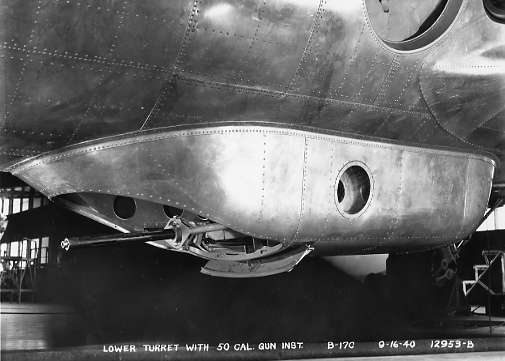
This "bathtub" position, so named for obvious reasons, was an attempt to provide protection from fighter attacks below the B-17C and D, with the gunner lying prone in the position and manually firing a pair of 0.30 caliber machine guns.
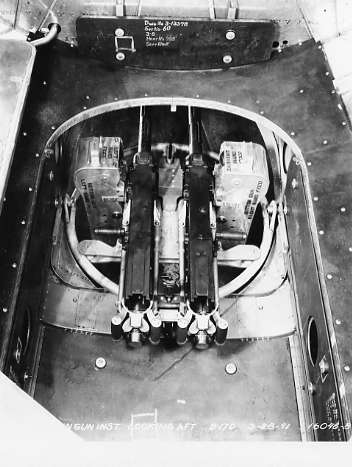
For the B-17E, the "bathtub" was first replaced by the Sperry remote power turret and, later, by the better known and ingenious Sperry-designed ball turret that equipped later Es and all B-17F and B-17G production.
- Tail Gun Compartment Under Rebuild: Also at Aero Trader and the reason Nick was there taking pictures of other stuff, is Nick's tail gun compartment under rebuild. This tail gun compartment was the heavily modified one originally installed on air tanker 44-85829 (N3193G), now flying as Yankee Lady with the Yankee Air Force. When the YAF was restoring the B-17, they obtained the Cheyenne tail from B-17G 44-85718 (N900RW) for installation. Nick traded for the old modified Cheyenne tail with the YAF back in 1993 or so. He obtained a bunch of original Cheyenne parts on e-bay and, combined with some new build parts coming from Tom Wilson, it is now being rebuilt back to original specifications by Aero Trader for him.
A view of Nick's tail at Aero Trader in August:
And, here is a view of a standard Cheyenne tail with a non-standard AAF gunner, both photos courtesy of Nick Veronico:
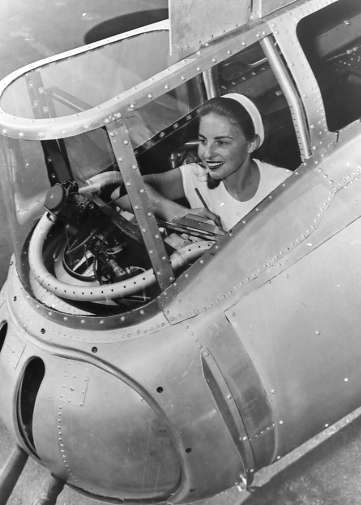
For those who don't speak B-17-ese, the Cheyenne tail was a tail gun modification installed post-production by the United Airlines modification center at Cheyenne, Wyoming, thus the name. The Boeing tail gun compartment is considered to be the "stinger tail" and the Cheyenne tail is the "Cheyenne tail." United Airlines basically removed the upper part and the aft part of the tail gun compartment from the factory tails and replaced them with new sections that enlarged the compartment for the gunner and added the "pumpkin" gun mount that increased the range movement of the twin 0.50 caliber guns installed. You'll have to figure out for yourself why it was called a "pumpkin" from the photo above. I can't do everything.
- Y1B-17 Data Plate Surfaces: No doubt that e-bay is an amazing place, even though it is not really a place and it tends to annoy people a bit too much. However, Dik Shepherd passed along the tidbit that he was able to obtain this little gem on e-bay:
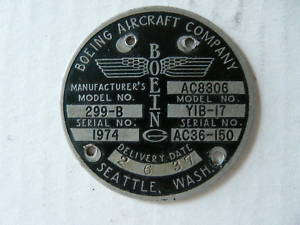
This would be Boeing's data plate for YIB-17 36-150, pretty remarkable in that is survived all these years. It shows the airplane delivered on February 6, 1937, with the manufacturer's serial number of 1974. How the plate got from there to here has to be an amazing story in itself. I am assured the dataplate is original, and it sure looks to be.
And, coincidently, while Dik was passing along this information, some photos that included this airplane were being posted by Scott (Second Air Force) Horchstein on this topic at the Aero Vintage Forum site, one of which is shown here:
Not sure how Dik knows this is the same airplane but I presume his files indicate as such. This photo is dated March 1, 1937, so perhaps it was taken at delivery. Pretty cool, eh?
- Another Obscure B-17 Movie Identified: Jim McSweeney passed along some information that a 1945 film he watched entitled The Way To The Stars contained some B-17 shots and they are seen several times. Well, I went to my local Internet Movie Database and found out this move was also known as Johnny In The Clouds and was a 1945 British release. I've added the title to my little list seen right here and will try and dig some stuff out in the future, whenever that comes. Thanks to Jim for the head's up.
A busy two months for me and for B-17 stuff. I was able to spend some time in early August visiting some B-17 projects, hitting Thunder Over Michigan with its eight, count 'em eight, B-17s in attendance, and also have a smattering of other stuff that came in the email and otherwise since the last update. This is a very long update so you'll either get bored with what I have here and move on, or sit back and peruse this page if for no other reason than to just get through it. Believe me, it took a lot longer for me to write this all than it takes for you to read it. Nonetheless, I'll have to be a bit briefer here just to keep this of a somewhat reasonable length...
July 2010
- Swamp Ghost Debut, Finally: The saga of B-17E 41-2446 took another step forward in June. On Friday, June 11, the airplane was officially unveiled to the public at an event held at the Tallichet-owned The Reef restaurant in Long Beach, California. A press announcement was made on June 3 that, strangely enough, was not picked up by the warbird community until the last minute. Fellow traveler Nick Veronico, who was in Berlin (yes, Germany) at the time, sent me a copy of the press release the day before the event was to be held and the word was spread through at least a couple of forum sites. Several real warbird people who have been tracking the story of this airplane actually made it to the event, including Chris Wilkinson, who posted a set of photos on webshots, three of which are posted here:
The event included speeches by John Tallichet, son of the late David Tallichet who was one of the early 1980s organizers of a recovery effort, and also Alfred Hagen of Aero Archeology, the gentleman who actually organized and followed through with the recovery effort in 2006. Also featured was a fly over by a P-51 and P-40 and a presentation of the history of the airplane and its return from Papua New Guinea.
This airplane is actually in remarkably good condition considering it was in a swamp from 1942 until 2006. However, there was no firm information about where the airplane is going nor what, if any, restoration plans are afoot. Earlier in the year it was rumored to be going to the Pima Air Museum at Tucson for restoration, but no mention was made of that possibility. The press release only states that "...the Swamp Ghost will be restored, possibly to flying condition, for display at an aviation history museum in honor of America's veterans..." As an editorial comment, I would suggest that a restoration to airworthy condition would necessitate so much replacement of structure as to diminish it's historical value, but that's just my little old opinion. The news release was a bit excitable, evidently, as it declares that this B-17E is the "Holy Grail of military aviation..." perhaps overstating things just a bit. Nonetheless, it is of great interest to most anyone reading these pages.
Whence from here? Secrecy or at least "no comment" seems to remain the name of the game. This airframe is in storage at the Military Aircraft Restoration Corp. facility at nearby Chino Airport. The forward fuselage is stored inside a hangar, with the aft fuselage and wing center section stored in the fenced lot behind the hangar. The remainder of the airframe, including wing outer panels and engines, are in a shipping container also at the MARC facility. I think it would be fair to suggest that David Tallichet was something of a silent partner in the Papua New Guinea recovery effort and thus the continued involvement in MARC and Tallichet's son. Where the airplane will end up, and with whom, remains the last great mystery of the story. Not bad for a Holy Grail.
- Thunder Over Michigan Still Has 8 Flying B-17s Slated: Yep, as of this writing the Thunder Over Michigan B-17 Celebration still has eight B-17s confirmed, whatever that means with 65 year old airplanes. Not to repeat myself from last month, but those would be, in no particular order, the following: Yankee Lady, Aluminum Overcast, Thunderbird, The Movie Memphis Belle, Texas Raiders, Sentimental Journey, Liberty Belle, and Nine O Nine.
Not a stretch to see a ninth B-17 joining the fun, though I can't imagine which one that might be. Also, maybe a younger, bigger brother stopping by. But in all cases, better to miss the show than push the luck. Doing things in a hurry with airplanes is rarely a good idea.
But, rumors aside, I'll be at the show hanging around the Liberty Belle and making a general pest of myself. I hope to get an opportunity to meet some people I've only been emailing for a couple of decades, maybe plug some Final Cuts, and enjoy the show.
- Details of 1972 Air Tanker Crash Surface: Air tanker operations in forest fire fighting were (and are) dangerous, evidenced by the seven B-17 air tankers lost in crashes between 1962 and 1972. Recently, I was contacted by Paul Harden, a New Mexican writer who was preparing an article about air crashes in the Socorro, New Mexico, area for the El Defensor Chieftain newspaper. He wanted some details about B-17G 44-83864 (N73468) that crashed on July 12, 1972, near Torreon Springs in New Mexico while fighting a fire with the loss of both pilots. Paul and I traded information and what emerged was a definitive account of the loss of the air tanker.
First, some background. 44-83864 started its service as a Navy PB-1W, being one of the twenty new Douglas B-17s diverted to USN service in the summer of 1945, part of the last block of Douglas production of the B-17. This view shows the airplane in its early utilization with the Navy:
It was used until 1956 when it and all Navy PB-1Ws were retired. This PB-1W went to NAF Litchfield Park in Arizona for disposal, as did most of the PB-1Ws, It and twelve other surplus PB -1Ws were sold in 1957 to the American Compressed Steel Corp. of Cincinatti, Ohio, being mistakenly reserved two civil registrations, N6365D and N5234V, with the latter officially being assigned in the end. American Compressed Steel quckly resold N5234V to a Mexican company, CIA Mexican Aero Foto, where it was used for photo mapping as XB-BOE. It was sold back into the U.S. in March 1964, going to the Mark Hurd Aerial Survey Co. of Santa Barbara, California, as N73468. It apparently never saw service with Mark Hurd, though, going immediately instead to Cal-Nat Airways at Grass Valley, California, for conversion to an air tanker. Here is a view of the airplane at Grass Valley before it was converted.
It flew with Cal-Nat for several years as tanker E56. Here is a view of the airplane at Spearfish, South Dakota, probably when it was sold to Black Hills Aviation in 1968.
In April 1968, it was then sold to Black Hills Aviation, first at Spearfish, then of Alamogordo, New Mexico, and added to that company's small fleet of B-17 air tankers. In the summer of 1972 it was one of the contract "borate bombers" stationed at Silver City, New Mexico. On July 12, 1972, N73468, flying as Tanker B11, was dispatched to a small forest fire on the east slopes of the Magdelena Mountains on what is known as the Pound Ranch. It was piloted by Robby Hillida of Alamogordo and Mark Sloan, Jr. of Las Cruces, New Mexico. A ground crew of 16 forest service workers had aleady been sent in to fight the fire, but there were concerns the fire might spread so air support was requested. At about 6:15 p.m. the air tanker arrived on the scene. On its first run on the fire, witnesses on the ground saw the B-17 drop its load in front of the fire and then saw the left wing tip of the bomber clip a tree, forcing the right wing sharply up. The pilot seemed to regain control of the B-17 when it then made a sharp left turn, apparently to avoid a rising ridge looming ahead. Reports suggest it then suffered an accellerated stall, rolled inverted, and crashed into the mountainside nose first. The crew was killed instantly. The tragic accident mirrored dozens of other such air tanker accidents...heavy airplanes in high density altitudes flying in challenging terrain with no margin of error, and many of dedicated pilots have given their lives in such conditions.
An investigation was conducted with the NTSB reporting a predictable cause. What was left of the airplane, reportedly the aft fuselage and tail section, was hauled off on flatbed trucks back to Alamogordo, presumably to the Black Hills base to salvage whatever usable parts that might remain. Paul provided the crash location on Google Earth, and notes that there are still shards of aluminum at the site. Apparently, it attracts deer and other wildlife and has become a bit of a hunter's lair. Paul notes that in this Google Earth view the crash site is in the center, with the remains of a dirt track running from top left to bottom right being a bulldozed path made so the flatbed trucks could haul out the wreckage. The coordinates of the crash site are 33.92221N-107.0850W, and it is ocated about twelve miles southwest of Socorro Municipal Airport.
There is nothing else to mark the site. Whether or not any parts of N73468 made it into any other B-17s, or if those parts are around today, is unknown.
An airplane crash from nearly forty years ago...just a footnote in history but these details fill out the framework of the story, and thanks to Paul Harden, it is a bit more complete.
- October 1942 B-17 Crash Details: Paul Harden detailed another New Mexican B-17 crash in his article. This one occurred near Magedelena on October 15,1942. He notes that an Alamogordo-based B-17E, s/n 41-9161, was conducting a training mission doing simulated bombing missions of various New Mexican "targets," the last being Magdelena. After the low level run, the airplane struggled to climb over the 9.500 foot summit of North Baldy. The B-17 hit the side of the mountain some thirty feet from the summit...all nine crewmembers were killed on impact. The subsequent investigation noted the mountain was charted with an incorrect elevation, being 200 feet higher than charted, though one could question whether the pilots planned their climb to clear the mountain so closely that a charting error was a causitive factor. Nonetheless, there were hundreds of such B-17s lost in domestic training accidents during the war. Paul notes that while the classified equipment and other radio gear was removed from the crash site, the fuselage, wings, and tail section remained on the mountain for years. Eventually, the parts wer hauled down for their salvage value. He notes that "today, only small pieces of the crash remain near the summit of North Baldy." Paul wrote the complete story of the crash and you can read about if you jump right here. All sorts of little tidbits out there about B-17s.
- More Crash Details--HK-580 in Colombia in 1962:
The fate of B-17F 42-3470 (HK-580) has always been a bit fuzzy...no definitive fate has ever emerged, at least to me. Research suggests that its last operator was Aeropesca, and it was used as a long range transport from Bogata to Colombian cities located in the Amazon River basin. Though it disappeared off the map in 1962, details have been elusive. Well, some definitve answers came to me in an email recently from Lisandro Arturo Zapata Mora who tells:
About the B-17 HK-580 that went to Colombia. The plane crashed in 1962 in the airport of Puerto Asis in a remote south jungle town. The air control did not advise the pilot about some cows in the runway and the plane overshoot landing and crashed at the end of the runway. Even though I had asked many time to many sources nobody knows exactly if the remains of the plane are close by the airport limits.
Thanks much to Lisandro for passing this information on, as it fills in a bit of missing information. Based on a look at the referenced airport, it seems doubtful that anything of the airframe might remain. The airport looks to be surrounded by development, but who knows? Here's another Google Earth shot, this one of the airport at Puerto Asis.But a group of friends still are looking for an answer to see if is possible to recover the plane and rebuilding for a museum.
It might be remembered that 42-3470 was one of the RFC airplanes and it went to Montana State College at Bozeman for several years, then went on the civil register of several countries including the U.S. and Nicaragua, before ending up in Colombia.
- Cucumber Bombers: N3701G and N4710C: Staying in the spirit of 1962, John K. Payne contacted me recently with some information about the unusual use of two B-17s in 1961 and 1962. John's father was John H. Payne and in 1961, he purchased two B-17s: B-17G 44-8543 (N3701G) and ex USCG PB-1G 44-85812 (N4710C). Over the next few years he and his company and his partner, Leroy Brown, operated them from the Bahamas to Florida carrying, for the most part, cucumbers. There have been some accounts of this opearation but John's account filled in some details and provided several photos.
Following is an edited account John sent to me telling of his father's use of his B-17s:
In 1961, John picked up something a little bigger. He and a friend, Leroy Brown, bought two surplus B-17s. Their plan was to fly vegetables from the Bahamas to the packing plants ringing Lake Okeechobee. Trouble was one of the planes had some questionable liens placed against it in South Texas. Leroy flew to Texas, bribed one of the line boys to fill it up, cut off the pad locks and flew off into the night, headed for Ft. Lauderdale. He arrived to a media storm. It seems that a rumor had started that the “bomber” had been stolen by Cuban exiles who planned to bomb Fidel Castro. When Leroy landed he was met by John, and many members of the press and law enforcement community. It all worked out alright, and they made their first “Cuke Bomber” flight later that week.
In January 0f 1962 John and long-time flying buddy Tom Zink were invited to join the Fort Lauderdale hanger of Ye Ancient and Secret Order of Quiet Birdmen. They were the first initiates into the new hanger. One night, after a QB meeting, John, Tom and Rob (another QB) decided to take one of the B-17’s for a little hop. They managed to get the engines started (not an easy feat), but unsure of the amount of fuel on board, and unable to get the radios working, they abandoned their joy ride. The B-17’s were sold in 1963, and one still flies the air show circuit today as "Chuckie". I made at least two flights with dad to Andros Island in the Bahamas in 1962 or 63, when I was 8 or 9. We would fly over a load of frozen or refrigerated food like milk and ice cream. Once there we would pick up a load of vegetables, usually cucumbers, and fly them to Immokalee, Clewiston or Belle Glade. This process saved three or four days getting the produce to markets up north. The loss of value in produce is directly related time between picking and consumption. Three or four days saved added enough value to offset the cargo fees.
Here's a photo of an airborne N4710C, still wearing its last Coast Guard air-sea rescue scheme.
FAA records show that N3701G was sold to John Gregory in May 1962. John adds the following about that transaction: "My father, a lawyer, pilot and general contractor was from Balston Spa, NY, just north of Albany. Thus, the name Albany Construction. John Gregory was dad's best friend, and that was probably a transaction for tax or other purposes. I am sure they kept flying veggies and ice cream." Both B-17s were apparently operated by this little group of friends until the spring of 1963 when they were both sold to Dothan Aviation for use as fire ant dusters. N4710C crashed in 1976 but N3701G continues to ply the sky as Chuckie.
Here is another photo, this of John Payne (left) and Leroy Brown with N3701G in 1962. His son John is also in the photo as a little kid running around behind his father. Thanks much to John for sharing.
June 2010
- Finally, An Update: Well, this update has been sadly overdue, for which I apologize to those who need the fix and come to this site to get it. Too many projects, too little time, is my excuse. Among those projects were some promised articles to a couple of magazines...Flypast put two of them on the fast track are already out in the June 2010 issue. I've also had some "other" little projects like a house renovation and my job, so something had to give. I've heard from a few folks asking why there was nothing new here, and that's the reason. But, to make up for it, here's a whole bunch of stuff that has been building up.
- Pink Lady is Grounded: One of the more important things in the world of flying B-17s is the grounding of The Pink Lady, officially known as B-17G 44-8889 (F-AZDX). Its a bit of a mysterious tale, but the upshot is that the group that operates the French B-17, Forteresse Toujours Volante, finally implemented what appears to be a long standing decision to fly the airplane on a one-way trip into La Fertém Allias where it will go on static display. The reasons given have been a bit fuzzy but evidently it is primarily due to insurance and other operating costs, though there were reports that there were offers made to pick up some of the costs. In any event, this long-operated, ex French IGN airplane, is now at least for the indefinite future, grounded. It should be noted that this was the last B-17 still flying to have seen combat in World War Two, having flown 6 missions during April 1945 with the 351st bomb group.
Ben Gilbert was kind enough to forward a few photos taken by Frédérick Vandentorren of the arrival at La Fertém in France on March 19, 2010. The airplane is to be parked outside awaiting the construction of a hangar. Thus, the number of flyers drops from thirteen to twelve.
- Miss Angela Is Not Really A Flyer, Sadly: Well, actually, I think the number of flyers, or the ones that I consider to be flyers, is really eleven. It has to be acknowledged that the airplane operated by the Palm Springs Air Museum cannot really be considered a flyer these days. The B-17G, 44-85778 (N3509G), otherwise known as Miss Angela, hasn't flown for several years and it doesn't look like it will be back in the air anytime soon. There are some "issues" being worked about the airplane that the museum has to work through. 'Nough said, I suppose. The airplane remains in excellent condition and it wouldn't take much to get it back into service. So, in the concept of online truth, a variable standard if there ever was one, we'll call the numbers of flyers as eleven. And it's my website, so I'll get to call it the truth.
- Texas Raiders Moves to New Home: The home base for the CAF's Gulf Wing Wing B-17G, 44-83872 (N7227C), otherwise known as Texas Raiders, was moved from Houston Hobby to the David Wayne Hooks Airport in nearby Spring, Texas, where the wing has found a new hangar and a new home at the Tomball Jet Center. The airplane was moved over in March 2010, and Sandra Thompson of the Gulf Coast Wing provided some photos, including this one taken by Col. Kevin Hong of Sector K Media LLC:
This first of the B-17 warbirds returned to the air back in October 2009 after a ten year period and has been undergoing some shakedown flights and paperwork processing. Things are in order now, and it has reportedly made it to several airshows in early May. It is planned that a B-17 ride program will shortly be in order. Plan to see this airplane out there quite a bit; it needs to make up for lost time.
- No News on Swamp Ghost: Yep, the news on the ex Papua New Guinea B-17E, 41-2446, is that there is no news. It is reportedly on the slowest moving ship that ever sailed somewhere between New Zealand and Los Angeles. I would venture a guess, though, that it has actually made landfall and is covertly making its way toward Tucson, Arizona, and its new (reportedly) home at the Pima Air Museum. Everyone connected with this airplane is keeping the details very close to their chests, so we await something definitive. This photo popped up in early March of the airplane in New Zealand, courtesy of Tom Wilson and "boys in New Zealand."
We await further news; I'd like to say you'll see it here first but there's that truth thing again and you probably will see it elsewhere first. Oh well.
- Model 299 Stuff: Before we go much further, it needs to be noted (again) that July 28th marks the 75th Anniversary of the first flight of the Boeing Model 299 from Seattle's Boeing Field. We shall provide a brief history right here about this milestone, with a bit of help from Ed Davies and my own little files. This is an oft-told story but bears repeating, just for the record.
The little Boeing Airplane Co. received the Air Corps circular 35-26 and Specification 98-201A, dated July 18, 1934, for a "multi-engined, four to six place bombardment airplane." The company's Board of Directors met on September 26, 1934, and committed a significant amount of the company's assets, $250,000, to the design and construction of a plane to meet the Air Corps request. Boeing had to have a prototype at Wright Field for a flyoff in August 1935, less than a year hence. The first major decision was that the airplane would have four engines as most manufacturers read the specifications as a request for a two engine bomber. The Boeing design team led by Gifford Emery and assisted by Ed Wells designed a relatively conventional but large airplane that used the two additional engines for performance rather than carrying a larger payload. The wingspan of the Model 299 was only slightly larger than that of the DC-3, and it was planned that four Pratt & Whitney Hornet engines of 750 hp each would be used. The design that emerged was of distinctive and impressive both as a bomber and as an airplane. It had five defensive gun positions faired into the fuselage was a huge airplane for the day. Construction was begun at the old Boeing Plant 1 located several miles from Boeing Field along the Duwamish River. The major subassemblies were barged from the factory to the old United Airlines hangar at Boeing Field in early July and then the final assembly was completed. The airplane was rolled out of the hangar on July 27, an amazing feat considering the complexities of the airplane, but a deadline loomed.
Upon it's public display on July 17, Seattle Times reporter Dick Williams dubbed the airplane a 'flying fortress' with its five gun barbettes. The big guys at Boeing saw that gem and said "thanks much...we'll take that" and filed a copyright for the moniker.
First flight ensued eleven days later (they did things a bit quicker in 1935) when, at 06:10 on the morning of July 28, Boeing test pilot Les Tower broke ground with the brightly polished bomber. A ninety-minute flight ensued, aftewhich Les Tower proclaimed the airplane a success. It enjoyed several weeks of testing, eight flights in all, with Boeing before delivery to Wright Field. That flight was accomplished on August 20, 1935, setting a new speed record in the process.
Competition was the Douglas DB-1, a DC-2 derivative, and a Martin entry, the Martin 146, neither of which were much inspired. All eyes were on the Model 299, and the Air Corps pilots and evaluators could see a winner. A flyoff ensued between the prototypes but the Martin design was clearly inferior. The DB-1 and Model 299 flew the various test profiles over the succeeding six weeks until, on October 30, the Model 299 crashed shortly after takeoff. The devastating accident killed an Air Corps pilot and Boeing pilot Les Tower, and was attributed by the accident board to pilot error: the elevator control was locked or partially locked and the airplane stalled after takeoff.
Technically, the Model 299 was out of the contest because it could not complete the test series. Boeing was broke and could not pursue a replacement prototype, as the Model 299 had cost the company most of its resources, $432,000 (that's $6.7 million in 2009 dollars). There was also the problem that Douglas quoted a price of $58,500 per copy for the DB-1 while Boeing needed $98,620 per copy for the Model 299 in a production lot of 220 airplanes. The Air Corps budget folks looked at that and noted that you could get two DB-1s for one Model 299 and proceeded with the math. In any event, the DB-1 became the B-18 Bolo (what the heck, Bolo!?), and the Air Corps bought 220 of those. Somehow, though, the Air Corps managed to procure thirteen Y1B-17s also, for a "service test." That service test kept the B-17 alive and, even though Boeing would lose money on each airplane they built through that contract, a toe hold was made for the design. The rest is, as they say, history.
So, all you B-17-o-philes need to dip your hat at 0610 PDT on July 28th as a measure of respect to commemorate the first flight of the Boeing Model 299. Set your alarms now.
- Thunder Over Michigan Has 8 Flying B-17s Slated: Yep, as of this writing the Thunder Over Michigan B-17 Celebration has eight B-17s confirmed, whatever that means with 65 year old airplanes. Those would be, in no particular order, the following: Yankee Lady, Aluminum Overcast, Thunderbird, The Movie Memphis Belle, Texas Raiders, Sentimental Journey, Liberty Belle, and Nine O Nine. Okay, you are right. It would be easier to mention the three flying B-17s that are not slated to attend (yet): Chuckie (possible); Sally-B (not bloody likely); and Fuddy Duddy (not likely but who knows?).
Also coming in on pick-up trucks are parts of four other B-17s. Actually, four teams of ongoing B-17 projects are working hard to have a presence at the airshow and maybe garner some support: The restoration team working on Champaign Lady (Urbana guys); the restoration team working on the Dyke Lake B-17G from Douglas, Georgia; and the team working on B-17E Desert Rat from Illinois. Also, expect to see some parts of the new build B-17C, a long-time coming project that is now peeking its head over the horizon. These guys need our support in every possible way, so if you are there drop buy and offer some encouragement and some money.
The theme for the 2010 show is Gathering of Fortresses and Legends, which may not be that catchy but tells the story of bringing together most of the flying B-17s for the 75th Annivesary of the first flight of the B-17. The show is being held over the weekend of August 7-8 at the Willow Run Airport near Detroit. That would be Michigan for the geographically challenged. Just north of Ohio. Now, there are going to be many other warbirds and a few of those noisy jet things that air shows seem to think they really really need, but we all know why people are going to show up at this one. May I suggest you check out the TOM website right here and secure your place in the crowd. I'll be there.
- 8th Air Force Historical Society Sponsors Event at Thunder Over Michigan: One of the events of note at the Thunder Over Michigan show is a special celebration by the 8th Air Force Historical Society. The group provided the following information:
The 8th Air Force Historical Society is hosting veterans, family members, and their guests at the Willow Run Air Show, located just outside Detroit, August 5 thru 8, 2010. The Air Show organizers are expecting 8 to 10 B-17’s to attend , 2 B-24’s, 12 P-51’s, the usual cadre of other WW-II aircraft, as well as a flying ME-262 and an ME-109.Attendees registered with the 8th AFHS and staying at our hotel within our room block will have preferential (back door) motor coach transportation to and from the event with delivery to a private tented seating and viewing area at center stage, as well as free access to several B-17’s offering “walk thrus” to the general public who, will be paying $5 to $10 per person for access. Our admission will include lunch, transportation, center stage seating, as well as dinner Saturday, followed by a symposium Saturday night. Optional tours will be available Friday and Sunday for those who only want to attend the Air Show Saturday. Our host hotel is the Crowne Plaza Detroit Metro Airport with complimentary airport shuttle, free parking for those driving in, and a room rate of $89 per night + tax. A limited number of Group Gathering rooms (or Hospitality rooms, whichever you prefer) will also be available at a nominal cost to the seven largest Groups in attendance with 30 attendees or more. There will also be a Fully Stocked 8th Air Force communal hospitality room welcoming all others who walk thru the door. PLEASE NOTE: This is not an 8th Air Force Historical Society reunion, but rather an 8th AFHS sponsored event, and you do not need to be a member of the Historical Society to attend. We were requested by the Air Show organizers to host the veterans and their guests in an “organized fashion,” which we are happy to oblige. We will have a large buffet “Welcome” dinner Friday evening, followed by lunch and dinner at the Air Show Saturday, with an interesting symposium to follow Saturday evening, and concluding with a Gala Banquet Sunday evening, with a very notable speaker. More information, instructions, and registration form can be found on our web site at www.8thafhs.org.
- B-17s at Oshkosh, Too: A week before the Thunder Over Michigan show will be the extravaganza at Oshkosh, Wisconsin. Held between July 26 and August 1, the annual super AirVenture aviation celebration will be also holding some special events to mark the 75th Anniversary of the B-17. The bigger celebration would appear to be for the 75th Anniversary of the first flight of the DC-3, with a massed forty-plus DC-3 arrival planned, plus a bunch of other Gooney Birds in attendance. However, there is a planned flyover of B-17s that will be held, maybe several times. No firm commitments have been announced from potential participants, but the word on the street is that there will be five or so B-17s in attendance. It doesn't hurt that the show is the week before the TOM event...two for the price of one, as it were. Note that on the evening of July 28th (Wednesday), there will be an evening show to mark the exact date of the first flight of 299 prototype that occurred, not coincidently, on July 28, 1935. Methinks the B-17 deal will get lost in the crowd, but I'll be there, too. Well, actually, I'll be there with a DC-3, but my heart will be with the B-17 guys, and so will as much of my time as I can squeeze out of my official, on the payroll, duties. Check out the AirVenture B-17 Information web page right here.
- Aluminum Overcast Has a Working Ball Turret: As detailed in the May 2010 issued of EAA Sport Aviation, B-17G 44-85740 (N5017N) now has a working Sperry ball turret. A small team of EAA volunteers spent a year and a half restoring the ball turret to operational condition, not an easy task as team member Christopher Ott relayed in the article: "We dealt with electrical connections not much bigger than a sewing needle that had to be installed correctly for the turret to work." That, and the intricate hydraulic system all made the effort difficult but commendable. Since the airplane was in town here in Sacramento, I trotted over to seen the ball turret, and the rest of the airplane too.
As noted above, the airplane is in the midst of its Spring Tour, so check it out.
- Yes, Sally-B Does Fly: It's been a rough couple of years for the crew of B-17G 44-85784 (G-BEDF), otherwise known as Sally-B, which also happens to be the only flying B-17 east of Maine (actually, it's based at Duxford in Merrie Olde Englande). Anyways, it has been flying recently and is slated for numerous events as posted on the Sally-B website. Proof of the pudding is in a series of nice photos sent in recently, courtesy of B-17 Preservation, Ltd. but really Peter at www.bomberflight.info, showing the airplane flying at Duxford in late April.
- Media Alerts:: As we draw near to the B-17's 75th Annviversery we have some magazine features coming out. Flypast magazine has a special separate magazine on the B-17 packed into its June 2010 issue that should now be out there. It features a number of articles with some good stuff on the Model 299, the development of the B-17 through the years, the French IGN airplanes (ahem, ahem), and the airplane held by the Lyons Air Museum, 44-83563 (N9563Z). Check it out.
- Details of the last USAF DB-17P/QB-17 Mission, August 6, 1959: I received a fascinating email recently from Paul Good, who spends his time working on the Urbana, Ohio, effort to rebuild 44-85813. The email is comprehensive so I shall include the entire thing.
Enjoy your web site and think your Final Cut is a great reference for anyone interested the B-17. I was assigned to the 3225th Drone Squadron from January 1959 to July 1962 as a pilot. I was primarily assigned to the QF-80 operations serving in all the drone flight positions at one time or another as radio control pilot, director pilot, safety pilot and both ground control positions; Romeo(rudder) and Echo(elevator). I also flew as co-pilot on a few B-17 missions so I had a working knowledge of that mission also. In your book Final Cut on page 21 you write, "the last DB-17/QB-17 mission being flown on August 6, 1959 with QB-17G 44-83717 being blown from the New Mexico sky by a Falcon missile fired from an F-101 Voodoo."
That is not entirely correct. Now for the rest of the story . The missions were often scheduled for multiple missile shots. The missiles many times contained a telemetry package in place of the war head that would read out the miss distance thus being able to gain the necessary test data without always destroying the target drone. On this mission the target drone was scheduled for multiple shots, in this case two AIM-4 Falcons and an Aim-9 Sidewinder all with telemetry packages in place of the warhead. The F-101 made two passes launching a Falcon missile on each pass. I don't remember the exact order but one of the missiles went through the aft fuselage around the gunners window and the other launch took off part of the nose section. After each impact the radar ground control site still had control of the B-17. The on site commander at the radar ground control site made the decision to continue with the launch of the Aim-9 Sidewinder from an F-104. The F-104 made a pass from the rear of the target launching the AIM-9 heat seeker which impacted the number 3 engine. At this time the radar site radar and telemetry showed they had control of the target and cleared the director aircraft in for a pick up. After the join up the director aircraft observed that the number three engine was on fire from the sidewinder impact. The airborne controller( who sat in the nose in the bombardier's seat) took control of the target and put it in a dive and succeeded in putting out the fire. With the fire out and still having control of the QB-17 they proceeded to return back to Holloman for recovery. After entering the pattern on downwind leg for runway 21 right they lowered the landing gear when the right gear fell out of the gear well and separated from the aircraft. At this point not wanting to land gear up and tie up the runway or have a fire to deal with they were order to take the QB-17 to Northrup Strip, an emergency strip at White Sands Missile Range used for such purposes. This strip is about 25,000 X 500 feet also later used as one of the space shuttle divert fields. The QB-17 was landed and came to rest intact running off the side a little ways. No fire ensued and a recovery crew was dispatched to secure the aircraft. The aircraft was later disassembled and trucked back to the disposal yard at Holloman to join many of it's kind. I flew a QF-80 mission later that day after it was down and flew over the area and took a look at the QB-17 sitting on Northrup Strip.
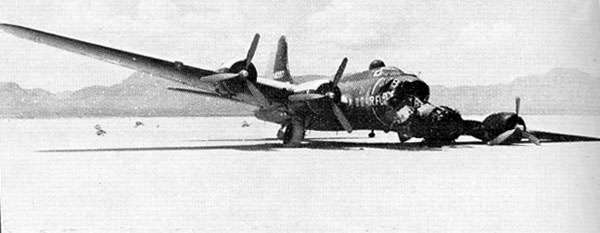
I'm surprised that this hasn't come to light sooner. I know it might sound like a made up story but I was there. I never thought much about it until I recently thoroughly read your book and being involved in the restoration of the B-17 Champaign Lady I thought the real ending of the B-17 service to our country should be known. It wasn't blown from the sky over New Mexico but returned after completing it's mission mortally wounded like many of his sister ships.
Early on during the restoration of Champaign Lady I discovered that the horizontal stabilizer we were restoring was from one of the DB-17s assigned to the 3205th Drone Group which was our headquarters group. I believe it was assigned to the drone squadron at Patrick AFB. I often kid the volunteers here that if I had known I was going to help restore a B-17 someday, I would have gathered up and saved some of those B-17 parts scattered in the desert. Scott, I'm sharing this with you so maybe you can include it in your next revision. If you want to put this on your site, I don't mind. If you want to take some time to verify this with your sources, I don't mind. I've lost contact with most of the drone troops stationed at Holloman during this period. We're getting scarce and stopped having reunions 6 years ago because of low turn outs. I also flew in the QF- 104 program at Elgin AFB from 1971 to 1973 as airborne , Yankee and Zulu controller. I was Yankee for the last QF-104 mission that was clearly shot down with a AIM 9L Sidewinder. I sort of saw the end of two drone periods during my Air Force days.
I thank Paul for his detailed account of this last DB-17/QB-17 mission as it really provides some nice information. It should be noted that the director airplane used for this mission was DB-17P 44-83684, that shortly afterwards went to Ed Maloney's The Air Museum at Claremont, California, that has since brought forth the Planes of Fame effort at Chino, where the airplane is undergoing its own slow restoration.
It should also be noted that "blown from the New Mexico sky" sounds pretty cool even if it's not quite accurate. Oh, well.
But, just to check to see if I make up things, I did look at my source document for my account used in Final Cut and culled this out of my files, an excerpt from the Holloman Rocketeer from Friday, August 14, 1959. Click on the image for the article. Interesting stuff.
As for the photo of the drone on the desert above, it comes from Pete Bowers' Fortress in the Sky and may not be from the incident related (the wrong landing gear is missing) but it is illustrative of the story anyways.
And, finally, there was at least one additional QB-17 drone mission (that did not use a DB-17 director) conducted from Patrick AFB in the summer of 1960.
- Stuff Is Still Out There: Rick Smith of Battlefield, Missouri, let me know that he stumbled across a direction finding antenna for a B-17, complete with the teardrop antenna cover. He found it in an old surplus store in St Joseph, Missouri, and was never used on an aircraft.

Thank, Rick, for once again showing that there are still little gems out there to be had, even after all these years. It will make a nice addition on the coffee table, eh?
- Luftwaffe B-17 in Spain: Joe Kendall passed along some information that I was not aware of but I thought was of some interest. It would seem that a 401st Bomb Group B-17G, 42-39969, went missing on a mission on January2, 1944. It turns out the airplane was forced down somehow, and the crew captured and held as POWs. The airplane was put into service by the Luftwaffe with KG200 and was used for covert missions, as were a number of other B-17s. On June 21, 1944, the airplane, in German markings, departed from Kalamata, Greece, carrying three German SS agents and two other passengers, bound for North Africa via a base in southern France. On June 26, it departed Marseille and ended up diverting to a Spanish air base in Valencia, Spain, upon which the German crew and passengers quickly disappeared. The airplane was interned by Spain at Manises, and it remained parked in a remote corner of the airfield. Somehow and for some reason, the airplane is shown as having been returned to the jurisdiction of the AAF in 1948, and it was carried on the AAF inventory as a TB-17G as of April 1948. Details are fuzzy, but it is probably the airplane was carried on the inventory only long enough to scrap it, as there is no further record of the airplane. Interesting little story. There are several links about this airplane, including here and here, a site that also has a link to this photo, reportedly the airplane in storage at Manises:
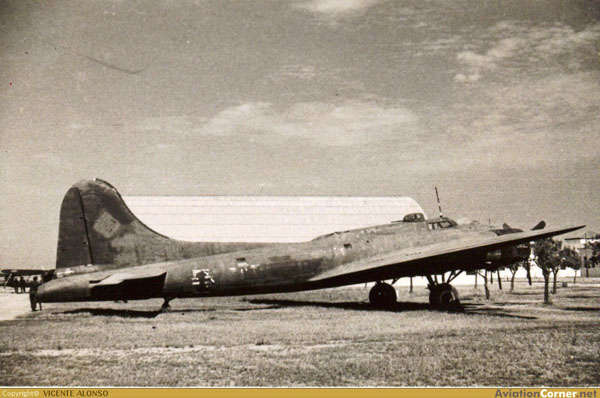
- Another RFC B-17 Added to List: In the course of doing research on the fourteen French IGN airplanes, I stumbled across information I already knew but didn't know it. There was B-17G held on loan from the War Assets Administration by the First Group, Michigan Wing, of the Civil Air Patrol at Flushing, Michigan. The was B-17G 43-39304, which records show as having been assigned to the 8th Air Force in England during the war. It came to Michigan probably in 1946 from the storage yard at Walnut Ridge, Arkansas, for use as a war memorial. It was "sold" on November 28, 1949, to Hubert J. Burke & International Air Corp. of Washington, D.C. and the civil registration of N9407H was reserved. It came to pass that the Civil Air Patrol did not actually own the airplane and thus could not sell it, but by then the airplane was on its way to France and the IGN where it became F-BADAT. It lasted until July 1950 when it crashed at Niamey, Niger, in French West Africa. Here is the only photo I've seen of the airplane with the Civil Air Patrol, courtesy of Todd Hackbarth and the June 1997 issue of Michigan Aviation where it was used in a cover collage. Cool.
I've added this airplane to the RFC B-17 Listing page that is slowly compiling all the war memorial and educational B-17s lent out by the RFC and WAA after the war.
February 2010
- Okay, to start off the 2010 News updates, the headline story is the sailing of the Swamp Ghost airframe from Lae, Papua New Guinea, on or about January 26, 2010, bound for an unspecified west coast (U.S.) port on the ship Pacific Pathfinder. Otherwise known as B-17E 41-2446, this airplane was released from the Papuan government after a nearly four-year international controversy kept it in storage in a Lae warehouse. The stated owner of the airplane is now Fred Hagen of Aero Archeology, with an agreement concluded (apparently) on December 10, 2009. After several studies and reports, it was determined that the transfer of the airplane was legal and authorized by the government of PNG. There is still bitter resentment among many of the principals in the dispute, at least if their quotes in PNG news accounts are accurate. Details of the December agreement reportedly provide for funding for a new national war museum and a full scale fiberglass B-17E replica of the Swamp Ghost for display at the museum. Here is a photo as posted on the authoritative Pacific Wrecks website showing the airplane being transported, presumably, to a dock for loading on the ship.
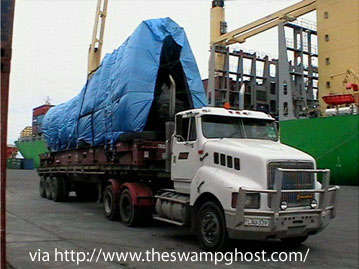
A search here finds the Pacific Pathfinder but not at a port in the PNG but it is in the area and ends up at Tokyo so who knows if that is the correct ship name and/or if it ends up in Tokyo, where from there? We will need to wait for details, or we can continue with endless speculation about what the plans are for the airplane. Time will tell, I suppose.
Just to feed speculation, I would imagine that once the airplane is somewhere on dry land, and detailed study of the aircraft condition will be made before any further plans are made. A flyer? Doubtful if that is possible unless much of the airframe is replaced, and then what do you have? Not much of the original airplane. Time will tell, I suppose, or do I repeat myself? So many questions, so few answers.
With this exotic B-17E in the forefront again, I should mention again the high quality Swamp Ghost DVD, which is reviewed right here. Good stuff and worth a purchase.
- So, lets open the B-17 box now and see what else is going on. On the horizon is the Thunder Over Michigan airshow set for the weekend of August 7-8.
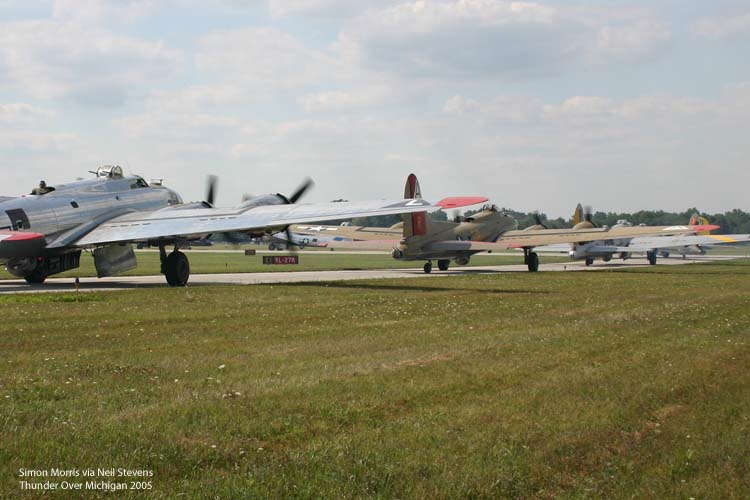
Sponsored by the Yankee Air Force at Willow Run Airport in Michigan, the theme for 2010 is Gathering of Fortresses and Legends. Notable to the event is that as of early February, seven B-17s have committed to attend the event. And, it would appear that teams from two restoration efforts, that of Desert Rat and Champaign Lady will also be on hand. No doubt there are other B-17 operators who might yet commit, so we could see a number approaching ten by August.
The year 2010 is the 75th Anniversary of the first flight of the Boeing Model 299 (July 28, 1935), so the B-17 design is rightly being commemorated. I, speaking for me, plan to be there one way or the other. Maybe a stowaway.
- Not to miss the B-17 wagon, the EAA announced on January 21st that it also would be holding a bit of a B-17 celebration at Oshkosh (a.k.a. AirVenture) this year. Since the Oshkosh event is being held from July 26 through August 2, the prototype first flight anniversary date falls smack in the middle. A special evening show is planned for July 28th, plus some commemorative flyovers. The EAA is inviting any and all B-17 operators to the event. No numbers are available yet, but having the Thunder show the following weekend will help bring the -17s in, hopefully. Not cheap to fly a B-17, and AirVenture doesn't provide any fuel assistance unless you are a featured performer and/or have some special arrangement going. I, speaking for me, also plan to be there one way or another. Maybe a stowaway. Maybe a DC-3 pilot.
Because, it turns out, that Douglas and Boeing cleverly planned to make "first flights" of two incredible airplanes in the same year....the B-17 in July and the DC-3 in December. Those guys were pretty smart, planning wise. Anyways, the EAA is making a bit bigger deal of the DC-3 Diamond Jubilee, specifically inviting 25 DC-3s to participate in massed flyovers and another evening celebration. And a DC-3 I am privileged to be associated with is an invitee and should be there if the federal budget does not implode. No assurances there. I'd give it 50/50.
In any event, you can go even if I can't, and there is much more information right here at the AirVenture website. Cool.
- Somehow it is symmetrical with history that with the 75th Anniversary of the first flight of the B-17, the Boeing factory building that produced most of the Boeing-built B-17s is going to be torn down. Boeing announced on January 13th that its historic Plant Two, better known as the B-17 Hangar, is to be demolished, probably in the summer of 2010 (irony again). There have been efforts over the years to preserve the complex, including a way to possibly move it and have it used as a part of the Museum of Flight. All for naught, apparently. The main reason is the complex is a cesspool of toxic waste from building B-17s and a whole bunch of other stuff. Chemicals saturate the ground from when they were disposed of by simply dumping....well, let's just say it was a different time. Boeing notes the following about the complex:
Location: On the west side of East Marginal Way South across the road from Boeing Field and backing onto the Duwamish Waterway.
Size: Four buildings cover 1.6 million square feet, about 36 acres. The main building was designed to accommodate nine fully assembled B-17s.
Production: During World War II, workers at the plant built almost 7,000 B-17 bombers as well as 380 DB-7 bombers under license from Douglas Aircraft. Other planes built there included Boeing's model 307 Stratoliner, the 377 Stratocruiser, and the B-50 and B-52 bombers. Also, the first four 737s were brought to near completion in Plant 2 before moving to another building.
So, another piece of history bites the dust. It should be noted that the Model 299 and at least part of the thirteen airplane Y1B-17 order were not built at this plant...they were built at Plant One (now part of the Museum of Flight) and barged to Boeing Field where they were assembled in a now demolished hangar on the east side of the airport (where FBO Galvin Flying Service is now located). Plant Two was, however, built in anticipation of the B-17 going into production.
- Going along with the demolition of Plant Two is the little item that two of the Museum of Flight's airplanes are currently stored in the main hangar, those being a B-29 and B-17F 42-29782, otherwise known as Boeing Bee and also N17W. The Museum has to make some plans to move and store both airplanes (there appears also to be a Constellation in the hangar). All those in favor of storing them outside in the storage compound, subject to rain and snow and sunshine and acid rain to wreak havoc on paint and Plexiglas and fabric and metal, causing the airplanes to slowly deteriorate and waste the efforts of dozens if not hundreds of people over the past years, raise your hands. Okay, I thought so.
So, everybody needs to support keeping these airplanes protected until they can go on display. And, just to whet your appetite and to see what we need to preserve in its current condition, Kevin Kelly happened to be at Boeing Field the day the announcement was made that the plant was closing, so he scurried on over and was able to get into the hangar (not an easy task, or so I've been told) and shoot a few photos of said B-17F.
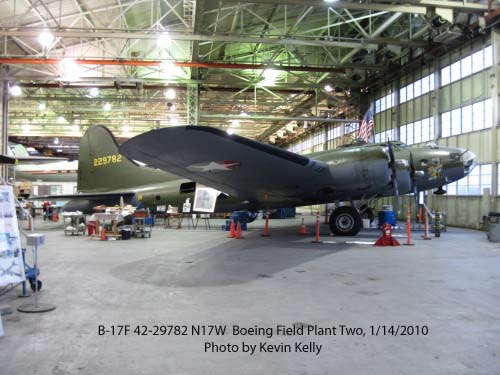
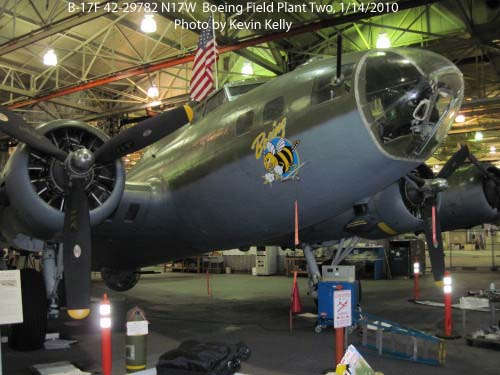
Some would ask (they always ask): Why is this airplane not flying? Well, mainly because the Museum of Flight has decided it is not going to fly, for various reasons (non-flying museum, insurance, qualified flight crews, visions of Stratoliners in Elliott Bay...not a Museum of Flight gig, by the way..., mechanical issues, etc.).
Okay, then why is this airplane not on display in the incredible museum? A tougher nut to crack, in this man's opinion. The Museum of Flight had its roots in the acquisition of a B-17, and the main display building was built to handle a B-17 hanging from the ceiling and/or set right square in the middle of the main display area. I think it is a fair question to ask why room for this airplane has not been made as the centerpiece. If there was no B-17 it is quite likely there would be no Boeing in its present form, and likely no Museum of Flight. This airplane should be displayed. The Museum of Flight is a well-funded museum by any measure and it has had big bucks for other projects and programs. But not for the display of the airplane that made Boeing and put Seattle on the airplane map. C'mon, get a move on, Museum of Flight people. The excuses are way past flimsy.
As a fairness matter, I'm glad to offer room right here or in the April update if a Museum of Flight people wants to explain why this B-17F remains in storage. Granted, only a select few read this stuff, but I'll make the offer anyways. Enquiring mind wants to know. Just let me know. Okay, one step off the soapbox; reserve the right to step back up.
- It is interesting to note the folks working on B-17G 44-8543 (N3701G), otherwise known as Chuckie, continue in their effort to put a pathfinder radar and associated equipment back in the ball turret location. As part of that process, a K-24 aerial camera was recently obtained, in the original box, no less, for installation in the radio room. Here is a photo of the box it came in:
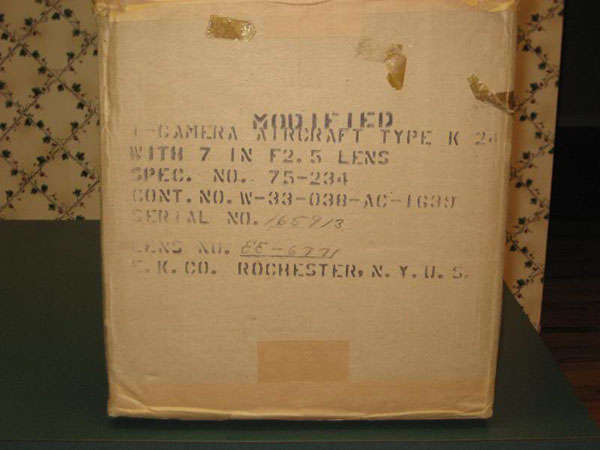
And here is what is in the box:
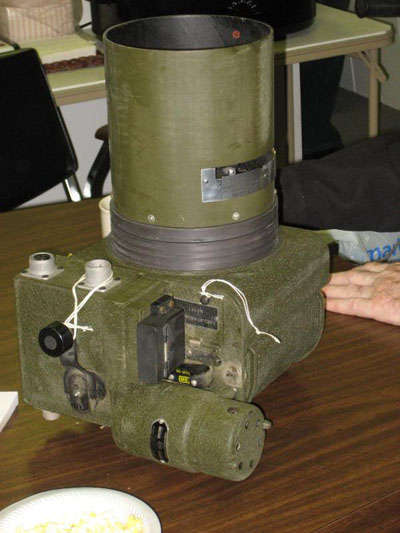
Some stuff will have to be fabricated to mount the camera, but it is all in an effort to recreate the radar and associated installation to match how this airplane looked while in AAF service. Thanks to Scott (Second Air Force) Horchstein for this information via the Aero Vintage Forum site.
- Michael Yamada, who has contributed photos here before, is now having his photographer friends pass them along also. Michael sent along this December 2009 photo of B-17G 44-85784 (G-BEDF),otherwise known as Sally B, of the airplane in a hangar, presumably at Duxford and in for winter maintenance. Old Sally appears to have some new nose art or I haven't seen the updated one...a bit skimpier than before, eh?
- An interesting photo was culled out of the internet by Steve Birdsall recently, and we went to work trying to dig out some more stuff on this airplane. The raw image, somewhat lacking, is held by the Southern Utah University Archives, and shows a B-17 with what appear to be D-Day invasion stripes. We requested a higher resolution copy and Paula Mitchell, the university archivist, quickly sent a copy along.
Yep, sure does look like invasion stripes on the wings, something you don't see too often. This airplane appears to be unarmed, save for a sole .50 in the left cheek window, and has the remnants of some tail markings. A closeup of the interesting area:
So, Steve went to work and comes back with:
This is 42-3354, Big Stoop. Assigned to 353rd Bomb Squadron, 301st Bomb Group on July 13, 1943, then transferred to 97th Bomb Group after 21 missions. Sent "to Depot" June 26, 1944 and finally salvaged overseas November 30, 1945. Her tail markings are 97th from the period prior to March 1944, but Fifth Wing was very slow to change in most groups. We know this photo was taken well after that.
I suspect the same aircraft, 42-3354, is shown in this series of official photos of General H. H. Arnold with Patton and Mark Clark at Castelvetrano airfield on Sicily. The 97th Bomb Group was called on to provide transport for the brass on other occasions, notably the Gibraltar meetings in November 1942. So maybe 42-3354 was performing a similar role as a VIP transport in the middle of 1944?
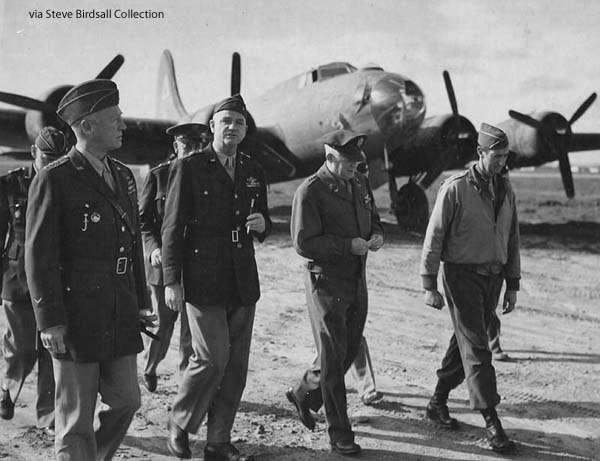
If they really are invasion stripes, it would date the photo after, obviously, June 6, 1944. Perhaps the summer or fall of 1944. So, there you go. All sorts of stuff out there floating around in cyberspace, and some of it is actually interesting.
- Alan Doner sent in several photos, one of which is a particularly interesting photo of what appears to be an early post-war B-17G at a field somewhere in Europe. Conjecture only. The "706" on the nose is the only clue to its identity.
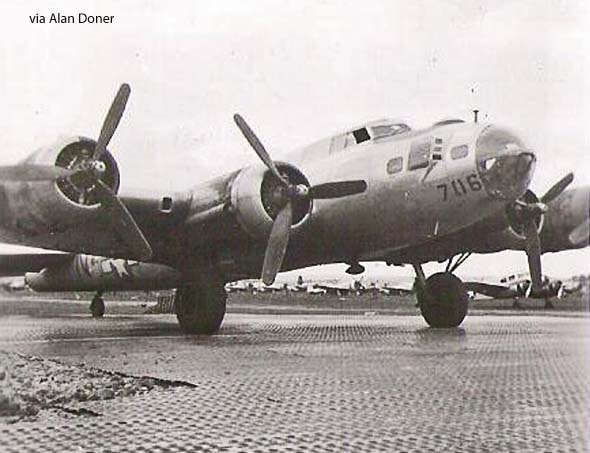
If it's part of the serial number, it could be 44-8706, a 305th BG airplane possibly used as part of Project Casey Jones to photo map Europe and Africa after the war.
That would tie it into another of the photos Alan sent in....this one showing several unarmed B-17s and veterans of the 306th BG (Triangle H), one of the two occupying Bomb Groups (305th and 306th) used to conduct Project Casey Jones.
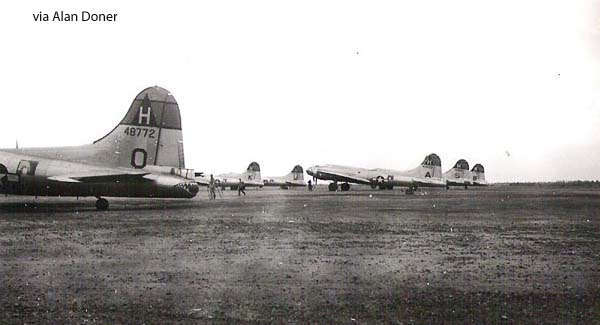
The nearest airplane is 44-8772, a Vega built B-17G delivered in December 1944. It flew as Low and Slow with the group in combat, then went on to the photo mapping project. Most of the B-17s used for that project had their tails blown off by the AAF in late 1946 at Lechfeld Air Field in Germany, then sold for salvage to the Germans. This airplane may have lasted a bit longer, the record showing it being salvaged in Germany in mid-1948.
- Speaking of blowing up airplanes in Germany, Dik Shepherd sent in this interesting photo, source obscure, date unknown, of what appears to be a field of B-17s in Germany having been disabled in a sad sort of way.
It may or may not be common knowledge that several hundred B-17s, mostly brand new examples culled from 8th Air Force replacement depots, were moved from England to Germany in the summer of 1945 to serve as part of the occupation forces, along with the organization of several bomb groups. Also moved were hundreds of A-26s and P-51s. They were stored at various depots for several years. When someone figured the Nazi's had calmed down enough, the B-17s were systematically disabled by setting charges off in their noses and/or tails, then giving or selling the scrap to German salvagers. I'd venture that this photo depicts part of that process. Interesting that one of the airplanes has its engines removed, the others not. The closest airplane does appear to be brand new, with only the basic AAF markings present. The A-26s were similarly salvaged, though it would appear many of the Mustangs made it through the refining process. Thanks to Dik for this little gem.
- Got an email from somebody, the entirety of which was "There is the 452nd Bomb Group Association" which I took to mean I missed it on my B-17 Links page. No further information, so I'm on my own to find it, which I did, right here. Thanks for the heads up from the man of few words and the situation has been now corrected. Nice website, by the way; check it out.
- UK Historian Neil Stevens passed along a pair of interesting photos depicting the remains of a Luftwaffe B-17 on a recently liberated German airfield in France or Germany, date and location unknown.
Neil tells us that these photos were taken from the collection of the late Joseph P Antrim of Chula Vista, California, who was Squadron Operations Officer of the 85th Squadron of the 437th Troop Carrier Group who flew from Station 469 RAF Ramsbury in Wiltshire in the UK and then from airfield A58 in France. Two 85th Squadron Code "9O" C-47's are visible in the background of the one photo.
The identification is tantalizing close, as these two enhanced and enlarged views of the photos indicate:
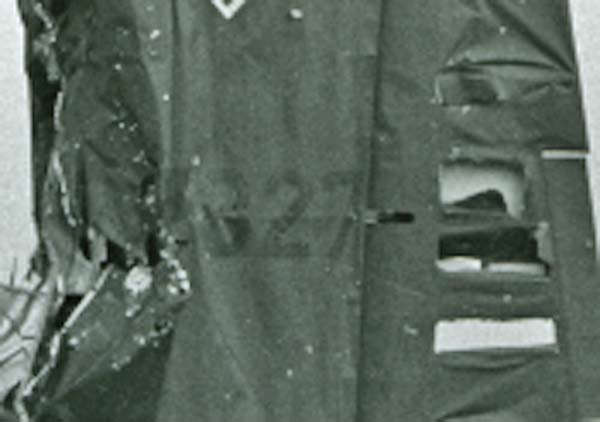
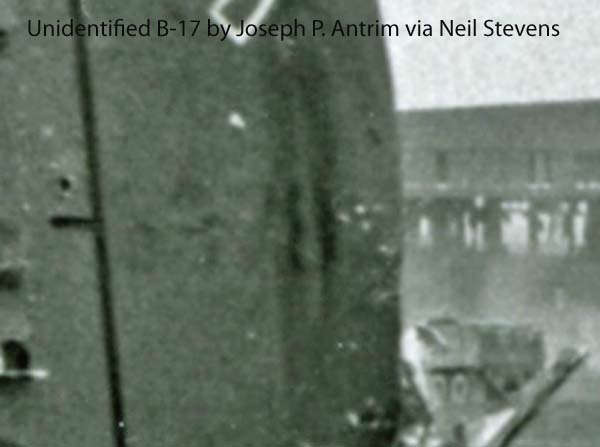
It was obviously a "G" series with the Cheyenne tail. Based on the above, the last three numbers of the serial (I think) are "827" and looking at the other photo, I suspect it could be either 42-37827 or 43-37827, both of which were lost in combat. The first was a 354th BG airplane lost on 4/13/44 and the second was a 305th BG airplane lost on 12/5/44. I will leave it to the experts to piece it together. Neither serial shows up on any list of Luftwaffe B-17s I could uncover, and both airframes appear to have crashed in combat vs. a forced landing. Standing by for experts with MACRs and things like that.
- Speaking of unidentified Axis B-17s, Ryu Ito was in contact with me recently about this photo that depicts an unidentified B-17E believed to be
taken at Djokjakarta (Indonesia) or Singapore. He is trying to learn more about this photo and the captured B-17s operated by the Japanese.
Mr. Ito writes:
I have a colour photograph taken in Djokjakarta (or possibly Singapore) showing a B-17E and Curtis-Wright CW-22 in a hangar during the Japanese occupation. The photographs came to light while during a totally separate research into the activities of a Japanese photographer who took the picture.
It was during my research into the location of the B-17E photograph that I came across your site.
I've also found reference from Japanese sources that a B-17E was observed at Bandoeng (possibly Andir) on 28th of June 1942. No photographs to accompany this information however. The B-17E in the photograph is likely to be 41-2471 since other circumstantial evidence and the diary entries for the 19th Bomb Group would tend to support this theory.
There are reports that as many as four B-17Es were recovered intact by the Japanese after the fall of Indonesia in 1942. This airplane might be one of them. According to the excellent Fortress Against the Sun by Gene Eric Salecker, 41-2471 was a 7th BG, 9th BS, B-17E that was "partially destroyed by burning at Djogjakarta 28 Feb 42. Found by Japanese after U.S. evacuation. Repaired and flown to Japan." The photo suggests that a name and/or nose art was painted out (under the nose windows) and a history of combat missions, kills, etc. was painted out under the cockpit. A cursory review of photos on hand doesn't match with anything, but these photos would have had to have been taken between December 1941 and February 1942, not an ideal time for photography for American flight crews. If anyone can shed light on this, please let me know and I will pass the information on to Mr. Ito and also post it here.
Of course, I did contact Steve Birdsall who is a great resource on early and Pacific B-17s. He checked his files and came up with a few clues, though nothing definitive. He did, however, come across this website with a plethora of photos of Japanese B-17s. I'd suggest anyone with the slightest interest in the subject take a look at the photos. The world wide web continues to amaze me.
- Finally, Roy Long sent me an interesting photos for all you Y1B-17 fans out there, and I know you're out there.
This photo was taken by Roy's father, Roy Long, Jr., in 1938 at Langley Field. Mr. Long was an Air Corps 2nd Bomb Group crewmember on the B-17s and recalls that they were practicing night runs over Richmond, and the black you see on the bottom of the planes was a mixture of 'lamp black' and water. They would wash it off later. The photo sure recalls a time long past; much simpler, better for some, not for others.
According to my well-thumbed copy of Freeman & Osborne's The B-17 Flying Fortress Story, aircraft #51 was 36-156 while aircraft #52 was 36-159. No tie up for aircraft #53. You can't have everything. Update: Dik Shepherd passes along that aircraft #53 is 36-161.
Cool, cool photo. Where else you gonna get this for free? Ease your guilt. Buy a book.
B-17 News Archive
2018 B-17 News
2017 B-17 News
2016 B-17 News
2015 B-17 News
2014 B-17 News
2013 B-17 News
2012 B-17 News
2011 B-17 News
2010 B-17 News
2009 B-17 News
2008 B-17 News
2007 B-17 News
2006 B-17 News
2005 B-17 News
2004 B-17 News
2003 B-17 News
2002 B-17 News
1997-2001 B-17 News
Back to B-17 Information
Back to the Main Page
Updated:
